


Ben Boutcher-West, Head of Mobility at AppyWay
Let’s face it, entering a multi-story car park with poor air quality, walking across car parks with moving traffic and even parking in general, is not the most exciting part of or even the reason for our travel. Especially in towns and cities underserved by public transport and other modes, you might consider parking a necessary evil for access to places of interest.
So why is parking still a thing? Well, automated driving is taking a little longer to reach us all than the first hype implied. While we all recognise we must drive less, reduce emissions and think about resources more sustainably, we do however still need access, access to all sorts of different locations to which we carry things, charge things, store things and deliver things. That’s why our project, ParkAV took a consumer look at parking today, the opportunity to improve the service and then a detailed look at the opportunity to fix parking over a 10 year period, making full use of new services and modes of travel while making parking forgettable for consumers.
The project, funded by Innovate UK, was also recognised as a key piece of connected vehicle integration improving the self-sufficiency of vehicles in our cities and also preparing for more automated systems of the future being able to buy access across both on and off street locations, joining up with a control system backed by the cities key performance indicators on clean air and congestion. EV charging was also a consideration, where, when and for how long are vital questions to fleet and logistic vehicles. These complex, supply and demand models have also been considered and over laid to the complex world of parking.
We felt strongly that very few people care about parking enough to enjoy a good multi-story layout for example, so key to the research was to help separate the consumer from parking altogether, keeping them safer and replacing the existing experience with service, better access and better value.
As a basic concept ParkAV looks at 3 themes:
● Parking. Today as storage but over time, time for service collection like EV charging, monetising assets in new services
● The distance between the consumer’s chosen destination and parking becomes further apart thanks to driven services or automation, moving away from a consumer's need to enter a parking facility at all.
● The business and data models to create a seamless, invisible customer experience while providing support to help cities thrive.
● Lucas’s navigation system knows where the club is and best parking nearby that is cheapest for the duration of the stay, nearest for Lucas to walk, and there is an EV facility - it asks the parking handler for reservation and awaits Lucas to drive there.
● One day, the navigation systems will know the AV capability of the vehicle and can drop Lucas and his housemate at the front door of the club before navigating to off street parking with EV and cleaning services further away
● Maybe that private trip with valet parking in the urban environment is only allowed by the city if the vehicle is then offered up for shared mobility services as part of a wider distributed fleet management system. Lucas can earn revenue from his car this way
● Maybe a fully dynamic automated fleet can collect Lucas and friend but can’t circulate in the city empty. It would require an on-street parking spot to drop people off but must self-navigate to off street parking for servicing and storage as at times of poor air quality or high congestion.
Regardless of the level of automation, vehicles move to all of these places already, with the exception perhaps the joining up to other fleet services though that is possible too thanks to the great work from Tomorrow's Journey, Car&Away and Turo amongst others.
ParkAV took scenarios like these and a great many other complexities into account to build a business model and a data exchange that enabled Lucas to pay for his mobility but then contract and serve all the players who support the trip. The energy provider, the storage provider, the team that cleaned the car, the congestion fee, the parking charges, the VAT differences between services like on street and off-street parking. How much is the dynamic parking charge anyway for that trip? With air pollution, do the locations change?
Together with JLR, Milton Keynes Council, Coventry City Council, and White Willow Consulting we answer much of this and more. Though the world is not quite ready for forgettable parking we do think we have a solution that can help cities thrive and get Lucas home by midnight.
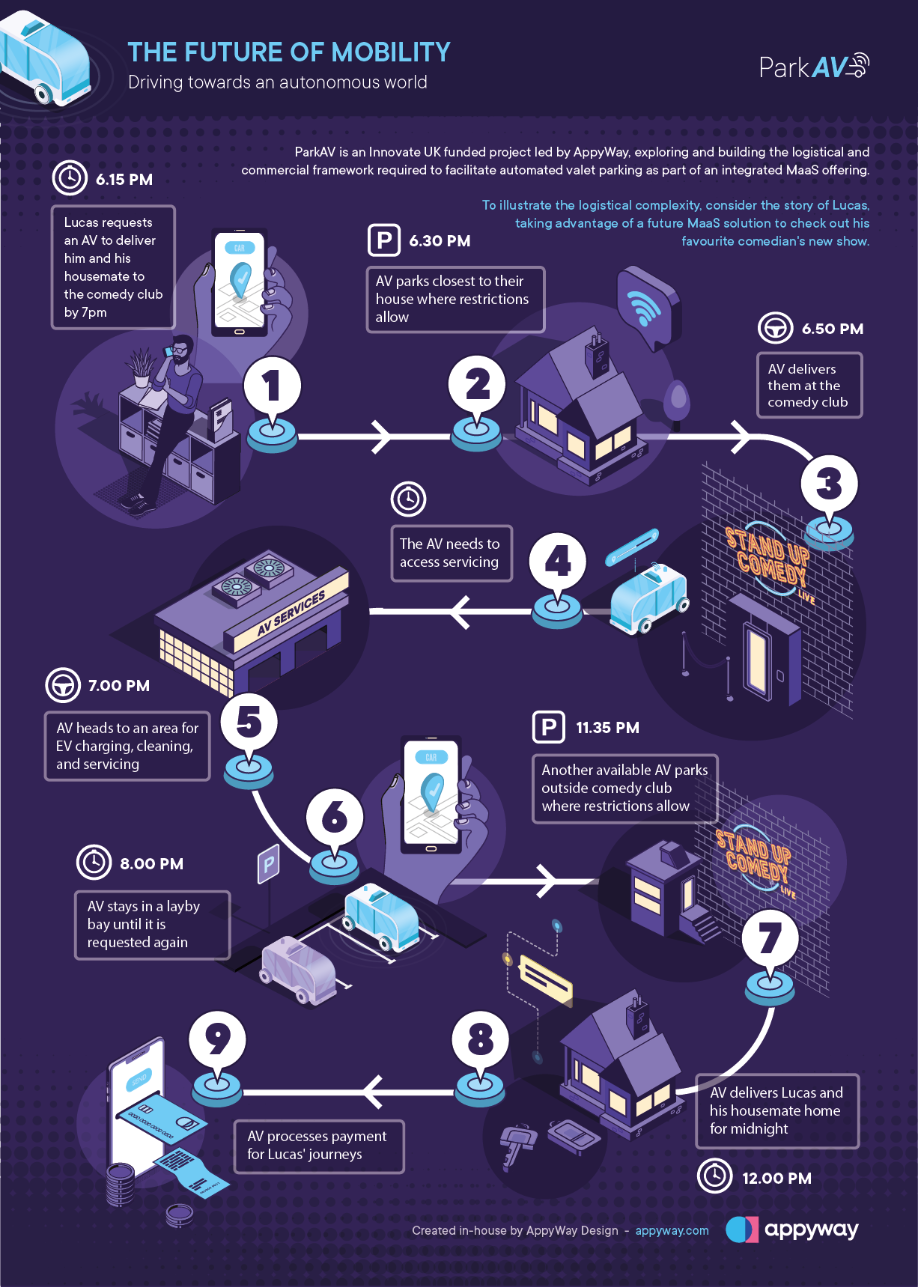

By Natalie Sauber | Market Intelligence and Future Mobility | Arcadis
Over the last years, the global awareness around climate change has seen a rapid increase. No longer confined to scientific research papers and conferences, the future of our world is now publicly addressed. After the signing of the Paris Agreement, the topic was further personalised by the likes of Swedish activist Greta Thunberg and Extinction Rebellion.
2020 changed all of that. We started the year with events of almost biblical proportions - droughts, fires, floods, and now a global pandemic. For the first time since 1918, when the Spanish Flu claimed anywhere between 20 – 50 million lives, we are faced with something entirely different on an international scale. Thanks to our highly interconnected lives, the virus knows no borders.
It has been months since nations around the world issued orders to stay at home. As we are slowly preparing for a gradual return to work, the question arises of how best to travel. While concerns around infection and social distancing might entice us to make increased use of our cars – the safety these small metal boxes provide has never seemed so inviting – we should not forget the environmental impact when making our collective decision.
Public transport and social distancing do not sit together
During the hight of the pandemic, usage of public transport had fallen by up to 90% on some of the world's oldest and storied transit networks: the London Underground, the Paris Metro, New York Subway and Tokyo's infamously packed trains. Will these commuters ever come back? In some parts of Asia, where business is opening up again, people are only gradually venturing back onto trains. According to data compiled by Bloomberg, morning traffic on the streets of Beijing, Shanghai and Guangzhou is now higher than compared to 2019 averages while subway use is well below these levels. First signs point to a slow return to normalcy for public transport usage.
If we decided to make social distancing guidelines a more permanent part of our lives, it seems undeniably clear that without significant changes we could not go back to pre COVID-19 occupancy levels of our public transport systems. The good news is that authorities can choose from an array of strategies and technologies to bring commuters back safely. These can be broadly grouped into two categories: minimising the risk of contagion within existing constraints and significantly expanding our transport systems to accommodate social distancing.
In the short term, new spacing guidelines in stations, on platforms and inside vehicles could help preserve safe distancing between passengers, while we put even more emphasis on hygiene via additional deep cleaning and disinfecting of surfaces. Effective and transparent communication is also key. Operators have been clear from the start: only travel when necessary, and this message needs continued reiteration. Contact tracing technology – so far mostly seen in Asian countries – is yet another effective way of locating potentially contagious individuals and ensuring they do not pose a risk to fellow commuters.
Ultimately, we must also think about the design of our public transit modes. Bus and train car interiors can be reconfigured to offer seats which are spaced farther apart and compartmentalised. Continued automation of payment systems would allow even better protection for drivers and service staff by avoiding unnecessary human interaction. In the interim, we will have to think about workable short-term solutions, such as disabling front-door boarding on buses to protect the driver even further.
The above measures might decrease the risk of contagion but will mean a reduced load factor of our public transport systems, leading to significant delays and longer commutes.
Ideally, we would increase capacity across all modes, but this poses significant technical problems and would certainly not be financially feasible. After all, most public transport authorities are already operating with stretched budgets.
While we look for ways to solve this, we can certainly expect commuters to look for alternative modes of transport.
Back to the future, err the car!
Studies – such as during the UK 2008-2009 influenza season – have shown that people who rode public transport were six times more likely to contract a respiratory illness. The natural reaction is for people to retreat to their private cars or, where feasible, make use of taxis or car-sharing services, as we have already seen happening across many Asian cities.
London Black Cabs and New York’s Yellow Taxis are already fitted with screens separating driver and passenger - now also seen in supermarkets and chemists – which will give users confidence. Quickly catching up, Addison Lee and Uber have announced new safety measures, such as fitting partition screens and making their drivers and passengers wear face masks.
Whilst, taxis and ride hailing services are generally looked after by their respective drivers, car-sharing services such as Zipcar, BlueSG or Ola Cabs pose yet a different challenge as they do not require person-to-person contact when being picked up and can also be used by multiple customers in quick succession. In fact, Zipcar even said that it is unable to professionally clean cars after each booking but that vehicles are “regularly and rigorously cleaned using our sanitizing procedures.” Hygiene concerns around multiple users touching the same surfaces may prove to be a deterrent to consumers.
But this is also not a solution
There are multiple reasons, however, for why we may want to avoid reverting to increased car usage. Studies have linked excessive time in the car to higher risk of developing obesity, a strong predicator of diabetes and heart disease. At the same time, the European Emissions Authority estimates that cars are responsible for around 60% of total transport CO2 emissions, not only a significant contributor to air pollution, but also to climate change. While these are all “far” risks, not immediately impacting our health and thus not at the forefront of public concern at this time of crisis, they nonetheless have the potential to alter our lives in fundamental ways.
When making decisions about our modes of transport going forward, it will be a balancing act trying to accommodate social distancing while working towards achieving our collective environmental goals and ensuring we do not lose the hard-won progress of the last years.
So, it is back to walking and perhaps cycling
There are of course other alternatives to vehicles. Pre COVID-19, many cities have struggled to keep their cyclists safe as they have prioritised drivers to avoid congestion. However, global lockdowns have changed this dramatically. Both bike use and shared bike use is up in many cities, and local governments across major European cities are even rolling out pop-up infrastructure to accommodate the boost. New measures, such as setting up temporary bike lanes and creating more bike parking are now being accelerated. London announced plans to create the largest car-free zones in Europe, while Milan and Paris have also introduced ambitious cycling and walking schemes. Lockdown may present the opportunity for citizens to reclaim the streets, reducing air pollution and adhering to social distancing guidelines.
Working from home = the new normal
At the same time, there seems to be one question that has so far been under-addressed. Have we considered that perhaps we are not faced with the dichotomy between exposure to the virus or increased air pollution, but instead simply a work culture issue? Here, the pandemic may have helped in altering our perspective. Work that only requires a computer and internet connection does not necessarily require people to be in the office five times a week. Many such businesses can in fact thrive under lockdown and some of the global tech giants were quick to act. While Facebook announced it will allow its employees to continue to work from home through the end of 2020, Twitter declared that it will let its staff work from home “forever”, and Amazon extended its work-from-home policy until at least early October.
If we collectively, and where possible, adjust our work culture accordingly, we could even further reduce congestion, air pollution, crowding on public transport and help avoid the spread of diseases on mass transit.
While we figure out how to operate under the “new normal” let us take a step back and appreciate that we can also use this pandemic as an opportunity to adapt our collective behaviour and create a more sustainable world. The environment and our future generations will thank us for it.
There has been a significant drop in production and sales in many manufacturing industries, with the automotive sector having been extraordinarily impacted. At the same time, the impact on the energy sector has drastically changed the cost of energy and the infrastructure in use to produce and distribute it.
These shocks not only had profound effects on each other but were also intensified by other geo-political factors like the drop of the price of oil to an historic low. This unprecedented context has created major uncertainties in how to maintain the EU’s long-term climate change ambitions.
The Threat: Going Back to Old, Unsustainable Ways!
Given the current context, the policies put in place for the EU to transition to a green and sustainable economy are now being re-discussed. Notably, some stakeholders have suggested to postpone the long-term goals of the European Green, which included the way forward to a complete transition towards zero emission transport, in favour of focusing on immediate and short term recovery plans.
AVERE firmly believes any EU economic recovery plan must integrate and enshrine the core values at the heart of the Green Deal. In fact, the recovery needs to strengthen the European Green Deal momentum by providing green stimuli for the EU to emerge stronger and more resilient to the climate crisis. This is the only way to ensure that the continent keeps its long-term climate ambitions and delivers on its aim of carbon neutrality by 2050
Climate change is still an all-too-real threat that needs to be addressed urgently and we cannot afford to fall back on old outdated production models.
The Opportunity: A Green Recovery!
In fact, this moment of crisis is an opportunity to increase the shift towards zero emission transport which will support the overarching EU economy.
This is why AVERE is a co-signatory of the initiative of the Member of the European parliament Pascal Canfin for a green recovery. It is the first pan-European call for the mobilisation of massive green investments to support the economy post-COVID-19 in a strategic way that enshrines the fight against climate change as a key pillar of the economic plan.
The vision encompasses many sectors, key of which is the mobility sector. Specifically, the initiative calls for any recovery for the automotive industry to be done in a way that fully fosters the uptake of zero-emission transport, with an emphasis on electrification on a mass scale.
The Strength of E-mobility to Reach Zero-Emission Transport
The full transition to electrified transport will require focused investments that would specifically support the production and purchase of electric vehicles that fit these criteria.
The returns on investment of this funding, in terms of overall climate change benefits, would be enormous, because of the direct and indirect benefits that stem from clean mobility technologies. Electric vehicles, for instance, provide better air quality in cities, and have a positive impact on public health. From an economic point of view, investments today would deliver extraordinarily strong returns tomorrow!
On one hand the industry could be provided with incentives to shift parts of its production towards a larger share of electric vehicles, with a drive to enable new technologies that would reduce retail costs.
On the other hand, consumers could be incentivized through tax deductions, to purchase new EVs or even to retrofit their cars, a market that was on the rise before the COVID-19 crisis.
However directly supporting the market for electric vehicles will not suffice. It is also necessary to ensure the infrastructure is in place to support these zero emission vehicles, such as the charging points and the renewable energy that is used to power them.
This is why together with the Electrification Alliance and other partners, we called on the European Commission to guarantee that specific recovery investments are aimed at zero-carbon infrastructure and innovative clean-tech solutions. These would lay the foundation for the perfect combination of clean mobility and the electrification of many sectors that would rely on renewable energy.
The path to a recovery that includes mass electromobility is not grounded just in funding but also in policies that enable EV uptake and support both industries, and consumers.

Bolster a Policy Environment to Support Electromobility
Europe is in the midst of the clean mobility transformation. In this regard, the policy framework must be safeguarded and strengthened to support the mass uptake of zero emission transportation.
We must not abandon the important results that have been achieved so far. Further to this, the EU’s 2020 CO2 targets for cars, vans and trucks must be kept in place. We believe these targets should under no circumstances be rolled back. Doing so would not only jeopardise the ongoing efforts to respond to the challenge of climate change but also cast doubt on the commitment of the European Union towards a green recovery.
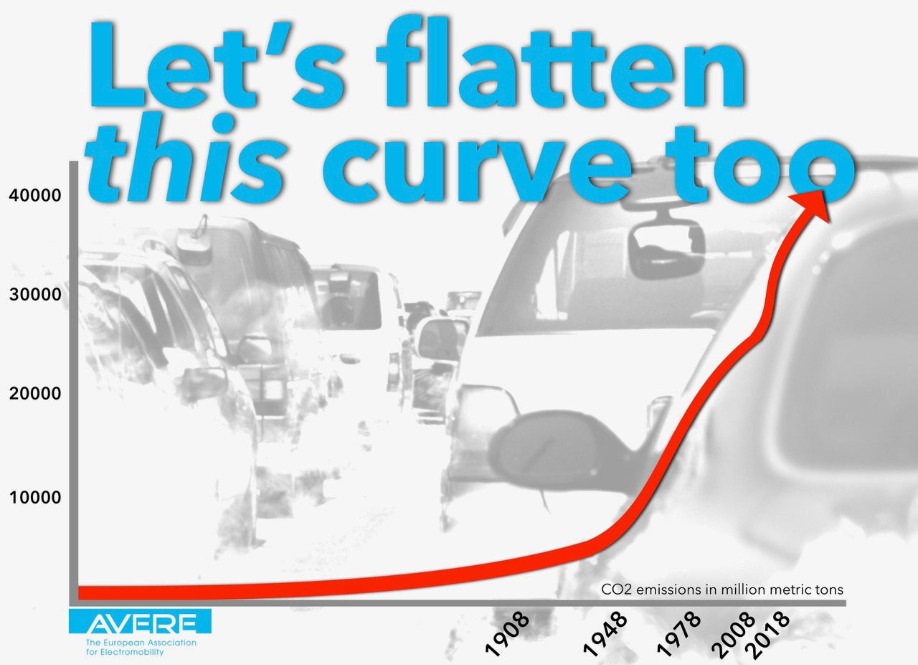
Instead of rolling back our accomplishments, we should look forward as to how we can support the growing market. In terms of policy agenda, an important milestone is the upcoming revision of the Alternative Fuel Infrastructure Directive (AFID), the European legislation that will help ensure that the infrastructure supporting electric vehicles will be fit for purpose for the coming five to ten years.
In the current AFID (originally agreed upon in 2014), with regards to EV charging points, Member States must have the appropriate number of recharging points by end of 2020 in order to ensure that electric vehicles can circulate at least in cities and towns. The European Commission has already started the official process to review the legislation which is currently foreseen to be announced in Q1 2021 with the goal of setting new ambitious targets to further develop charging infrastructure in Europe.
We believe this is the perfect opportunity to address some of the key issues currently faced by consumers. For instance, a more uniform approach to payments for charging across the continent, more transparency on the way prices are calculated, better access to charging in building like apartment blocks and more real time information for consumers on the availability of charging spots will be needed for the future development of the e-mobility sector.
A revised AFID that addresses these key issues will enable Europe to seize the growth opportunities that we had seen at the start of 2020 before the crisis hit.
Europe is on the brink of the transition to a green fully sustainable economy, driven by zero emission transport. Post-COVID-19, the EU needs to provide the right recovery plan that will enable business to emerge from the crisis stronger, while at the same time, ensuring consumers are equipped with the right incentives to make more sustainable and environmentally-friendly decisions.
AVERE - supporting the transition to electrification and establish the right policy frameworks throughout Europe to ensure that effective business models can take advantage of this development, whilst promoting the widespread use of electromobility in general and electric vehicles in particular in Europe and Africa, it is recognised by its members as representative body at the European level in the field of electric vehicles, acts in close co-operation with the European Institutions and with other international authorities.

By Jeffrey Davis, Senior Director, Government Relations and Public Policy at BlackBerry
The world of transport is changing every day, and the focus is on individual needs and multiple modes of transit. Automobiles increasingly have advanced technology to become more personalized and they are being developed to use alternate fuels, autonomous features, connect to entertainment, mapping, and even talk to each other and the infrastructure around them. Automobiles and the mobility system as a whole face a challenge they are not used to, cybersecurity. In an automobile traveling at 110 KPH, a threat can literally mean life or death.
In addition, consumers are sharing more information with automobiles than ever before. Contact lists, mapping, and even music playlists require direct connections to our most intimate devices – our phones. In an attempt to make a smart system, many automobile manufactures are working toward in-car payment systems allowing you to park, pay tolls, and even buy your morning coffee from your car. All of this means access to banking and personal data, which means that it becomes very attractive to some of the most inventive criminals in the world – hackers – and they are beginning to put that ingenuity to work. To make matters worse, this is all happening in an environment where the stakes are life and limb.
Automakers are well aware of the risks, and are taking action, but they face a special challenge. Manufactures are full of incredible engineers that have built some of the most complex and high performing machines in history. From brilliance in machine design to digital systems that on average have more lines of code than a jet fighter, automotive engineers design, test, evaluate, and redesign to ensure their creations perform safe and reliably. However, cybersecurity is not all about engineering, it is about security realized in a very technical space. This means adding elements that do not fit into the normal manufacturing process. They must predict how a criminal will see your creation, and how they will try to break it. They must adapt as attacks adapt and as techniques change, realizing that the most vulnerable component is the user. To complicate matters, consumers are demanding more and more tech, more and more connections, and therefore more and more threat vectors. Separating and sandboxing critical systems from consumer facing systems will reduce functionality as the functions of the vehicle become a part of consumer service. Which means there is a level of constant variation and updating required into perpetuity. In addition, automotive original equipment manufacturers (OEM)s do not construct the parts for their vehicles by themselves. Traditionally, upwards of 30 – 50 different suppliers provide parts and software to the OEM.
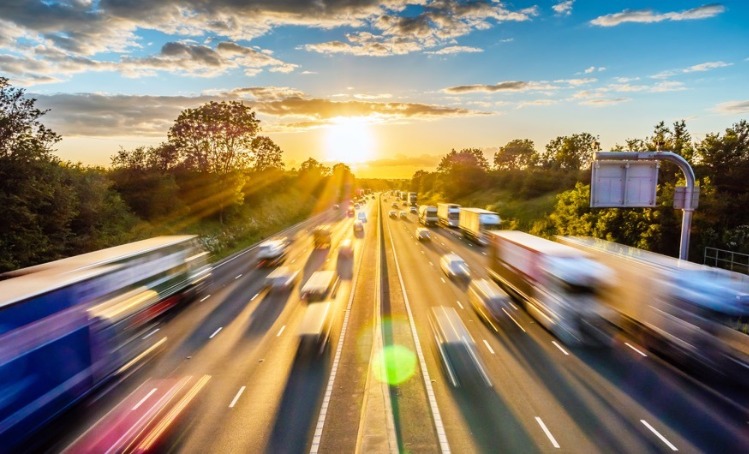
This adds an additional challenge of tracking of manufacturing practices, insider threat programs, and inherent vulnerabilities. Supply chain security is difficult in any industry. The Target hack in November 2013 is a perfect example. A point of sale malware was introduced into the Target system through an HVAC service provider contracted by the company. When you think of the possibility of indirect attacks, the danger of insider threats throughout the manufacturing process cannot be overlooked.
From bad to worse.
To amplify the challenges, it seems that hackers have found their way into automobiles already. A recent report by Upstream analyzed reported vehicle cyber-attacks occurring between 2010 and 2018. Attacks were divided between White Hat actors who were performing legitimate research and malicious Black Hat actors. While attacks against vehicles generally increased over time, the most remarkable change came in 2018 when Black Hat attacks outnumbered White Hat attacks. When malicious attacks outnumber those performed by researchers, it can indicate threat actors have discovered a security-weak industry, and more will come.
Another class of breaches, outside of the White Hat/Black Hat paradigm, consist of unintentional information exposure by vehicle drivers. Consider rental cars used by several different drivers, each who sync their mobile devices with various vehicle systems. When the car passes to the next driver, these systems may still contain personal or private data from the last occupant.
The same situation can arise when someone sells their car. If an automobile provides a web portal or mobile app that tracks the vehicle’s usage, the old owner may still have access. Used car buyers risk exposing data like geolocation information, garage door access codes, or various login credentials to the original vehicle owner. The car seller faces dangers as well, since old mobile Bluetooth’ connections may have stored contact information, music, and frequently visited locations.
What is the road ahead?
The most important step has already begun. In January 2016, a consortium of major OEMs and suppliers began the Automotive Information Sharing and Analysis Center (Auto-ISAC). This allows for the most important step to take place sharing information, intelligence, and vulnerabilities. All major OEMs and suppliers are members of the Auto-ISAC, and their numbers are growing every day. Authentication and credential systems are developed and in use in both manufacturing and in connected vehicle pilots and should become standard practice throughout the industry. Over-the-air-updates providing patches for vulnerabilities, making software and firmware updates openly available and ensuring owners and drivers are aware of the updates and the risk. Most important, the ecosystem must run on a zero-trust architecture that relies on continuous authentication, protection of endpoints, and continuous monitoring for anomalous systems behavior.
The truth of these new technologies is that they are more than just conveniences, they can make our lives more efficient, protect our environment, and keep our roadways safer. The first assessment that any risk manager must make is between risk and reward, and the promise of an autonomous, connected, and electric future is certainly worth the challenge of making it both safe and secure.

Currently, Senior Director, Government Relations and Public Policy at BlackBerry, Jeff Davis oversees the company’s smart transportation initiatives, working to grow the number of active pilots we’re involved in and representing the organization from an advocacy standpoint in industry groups such as The Intelligent Transportation Society of America (ITSA), Partners for Automated Vehicle Education (PAVE), ERTICO and the Automotive Information Sharing and Analysis Center (Auto-ISAC), and in directing BlackBerry’s development in smart transportation. He previously served as a Senior Vice President at ITSA, the nation’s largest organization dedicated to advancing the research, development and deployment of Intelligent Transportation Systems (ITS). Prior to that he developed new programs throughout the Department of Defense, as a Marine officer and contracted civilian.
Jeff has worked in technical and market development for 11 years beginning in defense as a project officer on several development and conceptual efforts across the operational and tactical spectrum, he moved on to oversee the creation and execution of comprehensive enterprise programs within the Navy and Marine Corps. For the past four years Jeff has focused solely on smart transportation including the implementation of cybersecurity practices, integration of connected and autonomous vehicles, and business cases around Mobility as a Service (MaaS).

By Graham Jarvis, Freelance Business and Technology Journalist and David Trossell (pictured), CEO and CTO of Bridgeworks
The Coronavirus COVID-19 pandemic is expected to change the way people work, well into the future. While the focus is predominantly on office workers being able to continue their roles from home, there is also an opportunity to enable a wide variety of industries to take their project work back to their humble abodes. This could even include elements of the Transportation-as-a-Service (TaaS), connected and autonomous vehicles (CAV) industries.
Despite the pandemic and after much wrangling, California’s Alameda County is permitting Elon Musk top re-open his factory in Fremont. An article of 13th May 2020 by Chauncey Alcorn for CNN Business reports, “We will be working with the Fremont Police Department to verify Tesla is adhering to physical distancing and that agreed upon health and safety measures are in place for the safety of their workers as they prepare for full production," county health officials said in a written statement.”
For some companies, there is an urgency to get back to work, given that the ability to manufacture vehicles or test autonomous vehicles in real-life conditions is being hampered by social distancing. Kyle Wiggers explains comments in his 28th April 2020 article, ‘The Challenges of Developing Autonomous Vehicles During a Pandemic’:
“The interruptions present a mammoth engineering challenge: how to replicate the data collected by real-world cars while the fleets remain grounded for months or longer. This problem has never been tackled before, and some experts believe it’s insurmountable. Even Waymo CEO John Krafcik has said that real-world experience is “unavoidable” in driverless car development.”
Yet, to entrepreneurs such as Musk, the interruption goes beyond business and the arguments against removing restrictions can both be political and emotive. Nevertheless, no matter what your views are on the lockdowns, Carol Schweiger - Schweiger Consulting, writing recently for Intelligent Transport, believes that the pandemic will usher in a number of changes.
Mobility trends
In her article for the magazine, she asks: ‘How has COVID-19 impacted 2020’s mobility trends?’ In response to this question, she predicts that Mobility-as-a-Service will become multi-modal with the integration of Traffic Management 2.0 (TM 2.0), Transportation Systems Management and Operations (TSMO) in 2020.
Amongst her other predictions, including an increased use of artificial intelligence and machine learning in public transport, is her view that autonomous public transport will be put into service. She explains:
“COVID-19 is likely to have a considerable impact on the deployment of AVs, particularly due to keeping transit operators safe from the virus. Around the world, transit operators have lost their lives to COVID-19, prompting transport agencies to employ safety measures such a rear-door boarding, eliminating on-board fare payment and installing panels next to the driver, significantly reducing driver exposure if travellers are paying their fare on-board or simply boarding through the front door. If AVs could be pressed into service sooner, drivers would not be exposed to the virus.”
Autonomous deliveries
Another perspective is mentioned by David Trossell, CEO and CTO of Bridgeworks, and it’s one where the virus could push forward autonomous delivery services. On 7th April 2020, the World Economic Forum offered its take on why this could be a significant emerging trend: “The COVID-19 pandemic has put an incredible strain on global supply chains, from medical supplies to household goods, as spikes in demand stress-test logistics infrastructures. There is an opportunity for unmanned delivery vehicles to assist in addressing this demand and help to reduce the risk of spreading infection.”
Trossell adds: “We ‘ll see more autonomous delivery vehicles. I don’t see COVID disappearing within the next few months, and the ability to immunise people is going to take months. So, the issue is how to reduce the contact between worker and customers. Look at Tesla, it’s planning to have autonomous trucks. Do you want a driver who’s been awake too many hours, or a robot that’s never going to get tired? With autonomous vehicles you can scale up without having issues such as this with personnel. COVID may accelerate their introduction.”
Talking about electric and autonomous vehicles, he also thinks that fuel-celled, rather than hydrogen vehicles, may be the best way forward with a view to improved air quality. He explains why:
“You can burn hydrogen, but combine it with oxygen in the cylinder of an internal combustion engine and you get “NOx” compounds such as nitrate, which forms nitric acid in raindrops. Then we have the whole acid rain problem we had when the world relied on coal for electricity generation. So, if we can improve the fuel cells, these may be a better way going forward.”
Autonomous railways
From a logistics industry perspective, and with care for the environment in mind, his ideal autonomous transport systems would be a railway. To ensure that the virus can be brought under control, he says most people need to continue to work from home, and that there is a need to reduce the number of people out-of-home, doing work they can’t do from home. One solution is to use an autonomous railway, which could carry the load of 50 trucks on the road, driven by at least 50 people.
He adds: “It’s a shame in the UK that we tore up much of our railway system in the sixties. If we still had some of that in place now, we could transform our roads and green capabilities. It’s a lesson to us all when we throw everything out of the door just to replace it with new technology. We have seen this in the IT industry when SSD and disks replaced many tape devices just to find that these devices become expensive to store the ever-increasing data volumes of data. Tape is coming back, not into the traditional backup arena, but in archives for all the data everyone is creating.”
Data: improving efficiency
The data that’s being collated on transportation should also lead to more efficient transportation systems. This could even lead to a more efficient and better utilisation of the road networks with electric and autonomous vehicles playing a huge part in this prospect. This could reduce congestion, making sure people don’t squeeze everything into just one day.
As a logistics operation or roads authority, for example, you could ask yourself: “What is the best time to put your truck on the road to save fuel?” Data could provide the answer, allowing you to work out the most efficient use of the road network of any given country. This requires us to have autonomous and connected vehicles.
However, he adds: “I think COVID-19 shows then we need faster networks, and they will need to be the backbone of capability. As people become comfortable and the self-discipline that comes in the end with home-working, they will require more efficient networking support – particularly for people who don’t live in conurbations but live in rural locations.”
The increased reliance on data for even transportation systems also means that there will be an increased demand for faster networks. Latency and packet loss in an era of big data analysis can lead to poor decision-making. People’s work locations may change, but latency and packet loss could still hinder them and their organisations. The mitigation of the effects of latency and packet loss will be particularly important in projects that necessitate the sharing, back up and restoring of large amounts of data and large files (e.g. computer modelling and simulations that use a high level of graphics), etc.
Enabling faster WANs
However, solutions such as WAN Data Acceleration can enable faster wide area network, improving project collaboration, real-time big data analysis decision-making and ultimately decision-making. While connected and autonomous vehicles will use edge computing to some degree, there will whenever the data is amassed still be a need to collate, share and analyse voluminous amounts of data between the different players within the TaaS, connected and autonomous vehicle eco-systems.
WAN optimisation can’t address latency and packet loss sufficiently. It also can’t deal with encrypted data. SD-WANs are a great technology, but they too could be improved by being overlaid with a WAN Data Acceleration, such as PORTrockIT. With WAN data acceleration it’s possible to achieve a complete transformation of these industries and improve the security of their essential data. Without it, they couldn’t operate. The future of TaaS and CAVs is data and how it is exploited.
Improving data security
Trossell explains: “To send data securely over WANs, we need to encrypt the data and for that we need encryption keys. Traditionally, these keys tend to be close to firewalls, as any WAN optimisation has to happen before we encrypt the data. For WAN optimisation to be most effective, it has to be the last thing before the data hits the WAN. On the other hand with WAN data acceleration, it is possible to accelerate encrypted data and push the encryption process and therefore the keys, back into the depths of IT systems, giving you more ‘doors’ to open or layers to get through to the keys.”
He concludes by suggesting people are going to have to relinquish control to another being if they want to continue to have personal transport. This requires putting a computer in control to gain a bigger picture of what’s happening on the road. Human drivers, he says, often can’t have all the information they need at their fingertips without the aid of computer and Vehicle-to-Everything (V2X) systems. V2X and Vehicle-to-Vehicle (V2V) communications permits vehicle to talk to each other, and with the infrastructure around them – allowing them to ‘think’ further ahead than a human driver.
So, one of the key outcomes – from Trossell’s perspective – will be to see the issues that pandemic has caused, including for mass transportation systems, as an opportunity to invest a huge amount of money in the digital infrastructure that’s required to manage it. This will also enable more Transportation-as-a-Service projects to be managed remotely, perhaps even from someone’s home.

By, Rubina Singh, e-mobility technologies and innovation at Centrica Mobility Ventures
In an increasingly connected world powered by smart technologies and data ubiquity we are moving towards a new era of connectivity encompassing phones, cars, homes and everything in between. This trend is only likely to accelerate.
What does that mean for the future of connected cars and connected homes, and how can we leverage the inherent opportunity?
The connected car market is growing fast at a CAGR of 24%, with more than 350m cars expected globally, accounting for almost a quarter of all cars by 2023 (CapGemini). McKinsey forecasts the total global value of connectivity to be between $450–750 bn by 2030. Meanwhile, the worldwide shipment of smart home devices is expected to exceed 1 billion units globally by 2023 (BusinessWire). This proliferation of smart home devices and increasing connectivity in cars is propelling us towards a future in which the two are integrated, with greater customisation as well as enhanced ease and convenience for users. Changing consumer preferences such as increasing environmental consciousness, a desire for greater control and customisation as well as a need to stay connected could further fuel this transition.
With smart speakers already establishing their role as a central device in homes, could intelligent personal assistants also be the future of cars and consequently bridge the gap between the home and the car?
In this article we explore what the emerging technology landscape looks like, what a future with connected cars and connected homes could hold and where opportunities may lie for various players across the automotive, data and energy sectors to capture value in this new world.
Innovation in the connected cars and smart homes landscape
Today, consumers can already benefit from smart speakers that bring a wealth of infotainment to the home and to their cars. We are seeing a convergence of smart homes and car infotainment with the likes of Apple and Google providing products across these two ecosystems. Smart thermostats and home energy management systems, such as Hive, can also optimise energy consumption and reduce cost. Consumers can also leverage voice activated lighting, security systems and smart appliances. As technology advances, we can expect home products to become smarter, gathering data on users for preconditioning and automatically complete actions leading to a truly intelligent home.
Similarly, new innovative technologies and connected services are emerging in the automotive industry as well.
Smart phone mirroring solutions have been around for several years but with wider connectivity through 4G and emerging 5G connectivity we can expect the plethora of infotainment services already available in cars to grow. The technology landscape is ripe with developments ranging from early stage commercialisation of vehicle-to-grid (V2G) connectivity and e-car wallets to a single biometric ID allowing for personalisation. There are also trials and pilots in progress for driver monitoring systems, gesture control, and virtual reality heads-up displays, as well as conceptualisations of transformed personal spaces powered by augmented and virtual reality.
The possibilities are endless and technological advancement, combined with a flow of data can blur the lines between the customer’s connected car and smart home enabling a truly intelligent and seamlessly integrated future.
What could this look like 5 years from now?
A new future powered by the convergence of three industries
Imagine that you wake up and it’s the year 2025. As you go about your morning, smart home appliances are preconfigured to your preferences. The front door auto-locks with a voice command and the security system is now on. Your EV, which has been participating in V2G to optimise energy costs is sufficiently powered to complete all your scheduled journeys and adjusts air conditioning and music according to your preferences. En-route, the connected car updates you on calendar changes in real-time and optimises the route. While you're in your meeting, the parked car receives your shopping in-car, delivered directly in to the car boot. At the end of the day as you make your way back home, your smart home starts re-adjusting settings according to your ETA. You are informed about a guest at the door who you can let in via voice control from your car. At the end of the day, your car is connected for smart charging overnight, which you remotely control from your sofa.
(And all of this is before autonomous vehicles become available.)
This ease and convenience of integrating connected car and connected home systems might be only a few years away. More so than ever before, we will see the car becoming more than just a mode of transport but an extension of your personal space.
Now indulge yourself and imagine what a truly connected and autonomous future could look like. Advanced biometric recognition could allow cars to auto-personalise settings for each consumer when they enter. Augmented reality heads-up displays and augmented interiors could change to suit your needs. With expected growth in Mobility-as-a-Service (MaaS) business models and increasing autonomy, there could be a move away from personal ownership to on-demand mobility solutions (Arthur D Little). Using advanced cameras and sensors, the car will self-schedule on-demand maintenance or a quick charge top-up when needed. An integrated single platform would help manage scheduling and billing for multi-modal solutions across a household.
Connectivity and smart devices are disrupting every aspect of the home and car, and indeed are transforming the way we live, work and use energy.
The increasing prevalence of kWh
The way we use and interact with energy is transforming. With the dawn of the EV era, the kWh will be as common in the transport industry as it is in households today. The convergence of smart homes and connected cars could also see the integration of home and mobility bundled solutions, enhancing convenience for consumers and giving way to new business models and ways of managing energy.
Some automakers have already launched residential smart chargers for EVs that connect to rooftop photovoltaic (PV) panels and home IoT for optimising and monetising energy across all devices. Many new opportunities will arise in this transformation for new services and models to capitalise on the increased flow of energy and data. For instance, in a connected and autonomous vehicle world, could car fleets be summoned to a stadium on game day to meet additional energy demands while generating revenues for their operators?
New business models to find value and capitalise on new opportunities
We are likely to see the emergence of new and different business models, and new players emerging to provide them such as:
· Digital service providers (IMS): companies providing digital services spanning smart homes and connected cars (e.g., peer-to-peer energy trading, infotainment, in-car deliveries, etc.)
· Data aggregators: bringing together home, car and customer data, which is analysed and sold to other organisations such as OEMs, retailers, insurance providers, etc. to enable the provision of customer-tailored offerings.
· Lifestyle/smart living-as-a-service providers (Gulf News): we could see an emergence of smart living-as-a-service models, that incorporate a range of solutions for connected devices, smart homes, cars, buildings and the consumer to provide an end-to-end smart lifestyle experience. Players in this area could provide platforms and products enabling customers to subscribe to or buy a bundle seamlessly integrating these services into streamlined offerings.
· Hardware providers: companies across sectors installing and maintaining the sensors, actuators, user interfaces, and other hardware to enable connectivity and convergence of services across smart homes, cars and consumer electronics.
· End-to-end solutions providers: bringing together a range of hardware and software services and solutions across energy and data to provide a holistic experience to customers. Centrica, for example, pivoted from the being the oldest energy provider in the UK to becoming an end-to-end solutions provider to enable the electrification of transportation, among other things. Centrica is already pioneering the development of products that combine state-of-the-art technologies with a world-class customer experience to create an integrated energy and transport system.
These are just some of the new and creative business models that could arise to enable adjacent industries to come together to create the ecosystem of the future while generating value for consumers.
The value of data
At the heart of this system lies the data across smart homes, cars and customers. This will be key to understanding customer preferences, changing customer behaviours, and developing new services and models to future-proof businesses while generating additional value. Partnerships across industries can be key to unlocking this hidden potential. Cross-industry collaboration – for example between companies in the automotive, information technology and utility industries – will be essential in understanding changing customer needs, enabling the convergence of traditionally siloed industries, allowing interoperability, creating new value and monetising it. However, in doing all of this, it will be imperative to protect individuals’ data and privacy if we are to sustainably enable this future which is so ripe with new possibilities.
The great convergence of the energy, transport and data sectors could truly disrupt the way we live, giving way to a cheaper, smarter, more convenient and cleaner integrated system.
About Centrica
Centrica is a leading international energy services and solutions provider, founded on a 200-year heritage of serving people. Through our two customer-facing divisions, Centrica Consumer and Centrica Business, we supply energy, services and solutions to over 26 million customer accounts. We serve customers across the UK, Ireland, North America and Continental Europe through strong brands such as British Gas, supported by around 13,000 highly trained engineers and technicians. We are focused on satisfying the changing needs of our customers, enabling them to transition to a lower carbon future. Our aim is to reduce emissions.
Centrica’s ground-breaking entry into the electrification of transportation began in 2012, when the first zero emission vehicles were delivered into our customers’ driveways and car parks. At Centrica, we are excited about the convergence of mobility and home energy into a new world of seamlessly connected customer experiences. We have recently announced a partnership with British motor manufacturer Lotus to develop a new model for EV ownership that fully integrates future mobility and energy.
Rubina Singh Biography
Rubina leads on e-mobility technologies and innovation at Centrica Mobility Ventures. Her previous roles span across technology development, setting up a new EV division and running cleantech innovation programs having worked in the UK, USA and Australia. She has published several papers on distributed energy technologies in international journals including IEEE, TechCrunch and PV Tech Power and is a regular speaker at international conferences. She has a M.Eng. in energy systems engineering from University of Michigan, Ann Arbor, and a B.Eng. in electronics and sustainable energy engineering from the Australian National University.
Power management and power distribution are often two of the most overlooked challenges when developing an autonomous vehicle (AV) platform. An AV needs an array of specialized sensors to see the world, including cameras, radars, and lidars.
Additionally, the vehicle then needs to process the data by way of advanced computing systems. Each of these AV components consume electrical power. While individual sensors might not draw large loads, the power drawn by a suite of sensors and computing hardware can be quite significant. Without sufficient and reliable power, self-driving vehicles could experience hardware faults – potentially causing substantial risk to both the vehicle and the world in which it is driving. Proper power management is essential to consider in the initial stages of developing and testing an autonomous research vehicle.
1. Vehicle Type
For any standard electric or gasoline vehicle, there are a number of electrical loads demanded from the vehicle’s power supply at any given time. Whether it’s starting the gasoline engine, accelerating the vehicle with the electric motor, powering the headlights or, operating the windshield wipers, these are functions that require various amounts of power. Then add in today’s comfort features – the power windows, audio systems, heated seats - all also drawing power from the vehicle. Now, AV developers are adding a huge additional layer of electrically powered devices to drive autonomously, making the vehicle an even larger power consuming system. The power required for these additional AV auxiliary loads is typically unable to be fulfilled by the vehicle’s current battery alone.
So how does vehicle type affect battery usage? Traditional non-hybrid/electric vehicles rely on a relatively small 12V battery to start the internal combustion engine. Once the engine is running, the alternator typically generates enough electrical power to exclusively power the vehicle’s electronics and also charge the 12V battery. If too great of an electrical load is placed on the alternator, it stops charging the battery, and the battery can even begin to discharge. Without an alternator, the battery will become discharged and the vehicle could shut down within minutes. The vehicle’s 12V battery lacks the storage capacity to run the vehicle for any prolonged period without the help of an alternator. Hybrid vehicles still have an alternator and a 12V battery, but also include a large high-voltage battery, and a much larger generator to charge the high-voltage battery. Hybrid vehicles also have the capability of converting the high voltage down to 12V to provide additional power for the vehicle’s electronics and charge the 12V battery. A full electric vehicle has the large high-voltage battery and generator of a hybrid but does not have the internal combustion engine of a traditional vehicle to provide supplemental power as the high-voltage battery becomes discharged.
For example, today’s fully electric vehicles have a maximum range of 335 miles, but the distance an electric vehicle can travel in a single charge varies greatly between different makes and models, as well as how many electronic comfort features are being used. Each AV component added to a fully electric vehicle reduces its mileage range, as it is consuming a portion of the battery. Hybrid vehicles provide significantly more electrical power required for self-driving sensors and computing systems without having a substantial impact on the mileage.
2. Computing Hardware and Sensor Suite Consumption
Today, AVs are typically developed on a retrofitted production vehicle. These vehicles are traditionally designed with 12V systems and generally will not support the computing and sensing power requirements of an advanced AV. Autonomous vehicles require sensors and computer processing that can perceive the surrounding environment and make real time decisions. Because these components are not directly connected to the power source of the vehicle, they are referred to as auxiliary loads.
The table below displays a few power requirements taken from a Dataspeed AV development vehicle. Take note these are theoretical maximums.
Component | Average Power Max. |
Drive-by-Wire System | 5A |
AV Computer | 15A |
Radar | 5A |
360 Lidar | 4A |
Forward Facing Lidar | 4A |
Camera | 3A |
GPS | 2A |
Ethernet Switch | 2A |
Depending on the size of these auxiliary loads, they can make a significant difference in terms of power requirements. Autonomous vehicles, depending on the level of autonomy, are often outfitted with multiple lidar sensors. Depending on the technology of the sensor, they could each draw upwards of 4 amps. An AV system could require between 2-8 lidar sensors. While individual sensors might not pose a significant load on the electrical system, the power consumed by an array of sensors can be significant. It is imperative to ensure there is ample power supply for sensors and other hardware to remain functional and dependable.
3. Flexibility
Sensors, computers, and power supplies often need to be changed, swapped, and reconfigured in order to meet the needs of engineers and developers. Having the ability to make those necessary adjustments quickly allows for easier power management and faster development. Utilizing a power solution system, such as the Dataspeed Intelligent Power Distribution System (iPDS), can expedite hardware changes on the fly. Whether it’s for introducing new technology, or evaluating sensors, a well-designed power distribution system allows for simple integration while saving valuable installation time.
Placement of where the AV power distribution is located in the vehicle is important. The power distribution is often located in the trunk of the vehicle, but developers want to control power distribution from the comfort of the driver seat. Having the flexibility and capability of being able to power items at the touch of a button can simplify development. For example, it is valuable for developers to have the ability to power cycle sensors with the touch of a button, especially if the sensor is not easily accessible. Users can quickly toggle power to individual sensors by using an intuitive interface that conveniently controls a power management system, like that of the cupholder-mounted touchscreen display of the Dataspeed iPDS.
4. Programming
Heavy loads on initial start-up of a device could cause the main line supply voltage to drop. Direct hardwiring systems to the vehicle battery, utilizing UPS systems, or other in-house power solutions often do not allow for proper circuit monitoring or sequencing to prevent software startup errors. If a sensor needs to be turned off or power cycled, the entire system would need to be shut down in those types of setups. Below are a few real-world examples of the power programming needs from experts in the AV field:
· An engineer wants to manually drive a test vehicle to gather sensor data. They only want to power up the sensors and the computer. No other sensors or equipment need to be turned on.
· A company would like to automatically to turn on safety driver cameras as soon as the vehicle is started but would like to require the safety driver to independently power other devices.
Power distribution systems that feature programmable start up and shut down scripts are useful to create power harmony amongst all components. Some devices draw more current than one channel can provide. With an intelligent power distribution system, power-heavy devices can be connected across multiple channels. Those channels are then programmed to turn on simultaneously, which provides a reliable and controllable power cycling strategy for larger loads.
5. Engineering Experience
Companies building an in-house power solution must consider their engineering team’s automotive experience and knowledge. [VC1] Are they familiar with the make and model of the vehicle being retrofitted? There are a myriad of nuances for each AV component being integrated into the power solution. For example, is a chosen sensor designed to be powered via 12V DC? Although it’s typical for automotive components, some sensors require different voltages. In that case, they would have to implement a voltage regulator to achieve the desired output. Expensive sensors could be easily damaged or may not power on if this isn’t done correctly.
Plug-and-play power distribution systems allow for quick and easy integration into a vehicle’s existing power architecture. These systems allow engineers of varying backgrounds to connect hardware on their own without having to wait on a technician to install. Once a power distribution system is installed, there is often little need to connect devices directly to the battery anymore, which allows devices to be more safely installed. By using a power distribution system with an intuitive hardware interface, simple devices can be connected without a great detail of technical knowledge or wiring experience, which can reduce the risk, time, and cost associated with AV power management.
Deciding on A Power Solution
Computing hardware, sensors, and other technology that have been added to an autonomous research and development vehicle affect power consumption, thermal management, and heat loads. It’s important to consider vehicle type, hardware power consumption, flexibility, programming, and engineering experience when choosing a power solution. The need for an adaptable and easy-to-use solution for powering instrumentation, computers, and sensors of a test vehicle is essential.
Dataspeed has created a comprehensive, programmable power management system that that has long been a favorite in the automotive testing industry. By utilizing the Dataspeed intelligent Power Distribution System (iPDS) for power distribution, a development team can rely less on automotive experience and expertise when installing a new sensor, device, or equipment, all while allowing for easy configurations of channels, thermal management, over-current diagnostics, programmable startup/shutdown scripts, and more.
Dataspeed Inc., provides complete autonomous research and development vehicle integrations that allow engineers to get up and running quickly on their algorithm, sensor, or data research. Dataspeed’s industrial grade by-wire solutions form the foundation of these platforms with expert software and hardware engineers with their driverless car projects, including sensor developers, mobility-as-a-service providers, teleoperators, research institutions, and government agencies.
Electric mobility has great potential to reduce CO2 emissions into the atmosphere if the right decisions are made. In the current fight against climate change, however, we are caught in the green ideology by the “end-user zero-emission” dogma.
By Hans Rodestock, CEO of HR-FuelCell
HR-FuelCell is an innovative idea leading to reduced CO2 emission, thus making a positive contribution in the struggle against climate warming - https://hr-fuelcell.com/
Various thoughts are banned as the great enemy of the environment; but is it really helpful to be persistent behind an ideology? Asking questions and looking for options is always helpful and represents progress. In order to minimize climate change, the energy consumption of an entire system must be reduced per mile travelled. This does not only mean the use of electric mobility. It is also important to choose the most efficient way to supply energy. In our counts, energy consumption should always be linked to the emission of carbon gas, as this could also be used elsewhere. The result is not to give up efforts to minimize carbon gas emissions, but also to reduce energy consumption.
The focus of our mobility should be changed from the "Tank to Wheel" view, which forms the basis for the zero emission of the end user, to "Cradle to Grave". If you spread the “Tank to Wheel” view, you would also fulfil the saying: “I am green because my garden is clean!” The obstacle is that the system is much larger than your battery-operated electric vehicle. To believe that the electricity comes from the socket and that the car already has a battery when you bought it is really short-sighted. What would really help reduce carbon gas emissions? The technology of electric vehicles is usually more energy efficient than that of conventional combustion engines in terms of the entire system, including production and all surrounding units, as well as recycling. It must also be seen that, as there are different fuels for driving combustion vehicles, electric vehicles also have different energy sources. One is powered by batteries and the other by different fuels using fuel cells. Even if the EV powertrain is exactly the same, only the power source differs. It makes a big contrast in terms of efficiency, economy and comfort. The most important thing for a new technology to minimize climate change is the efficiency of the entire system. With the battery-powered electric vehicle, many people have the illusion that zero emissions by the end user are the answer to all problems. Unfortunately, this is not the case. The provision and operation of the energy infrastructure from the manufacture of the storage devices to the use of the system is very energy-intensive. It contains much more than a windmill and to charge a BEV for operation.
FCEVs are more effective in efficiency, but there are differences. Two main types of fuel for operating a fuel cell give us a perspective for reducing carbon gas emissions. The hydrogen fuel cell appears to be the cleaner and is an emission-free end-user technology. But even though hydrogen is the most common element in the universe, it is not accessible to us in the way we need it for use in cars. It is only available in combination with other elements and must be separated in an energy-intensive way so that it can be used. Another obstacle is the infrastructure, which requires a lot of energy in comparison and is very expensive due to the technology required. With methanol, we have another important energy source for fuel cells, a fuel that is damned because it does not meet the requirements of zero end-user emissions. This can happen when the ideology overrides rationality. We should support an energy source that reduces the energy consumption of the entire system and not particularly. It is true that the HFC directly in the fuel cell has a higher efficiency than an MFC, but this is again the idea of "tank to wheel". The entire methanol system is more energy-efficient in terms of production, operation and maintenance and significantly reduces the emissions of carbon gas. Choosing the right technology to lower the carbon footprint of the entire system is one side, but public acceptance also requires great attention.
A very important point for the success of a technology to minimize climate change is the economy! Spreading to a large number of users through the acceptance of ordinary people, corporate accountants and the ability to afford it is most important to really achieve the goal of reducing carbon gas emissions. An obstacle to the spread of technology will be when only a few solvent enthusiasts can put their thoughts into practice. Who will pay for it? It is not a question of whether a large number of users want the new technology. There is more to ask if they can afford it. The vast majority of private drivers need their cars for everyday use and have to count for every pound. This barrier has to be overcome. The same problems we see in transportation companies and in communities, every pound has to be turned twice before it is spent. There are initiatives for small alibi environmental projects everywhere, but the breakthrough always fails on the accountant wall. It is understandable because everything has to be offered at reasonable prices. Battery-powered mobility has its high cost in its device itself and the enormous energy consumption, as well as that green electricity is more expensive and is only acceptable to most users through subsidization from other sources. Hydrogen technology is also associated with high costs. In order to be usable, it has to be energy-intensive converted and the infrastructure requires very high standards with expensive maintenance work. On the economic side, methanol technology plays a role again, it can be produced ecologically and inexpensively, and the infrastructure is already provided through the common petrol stations with their known low costs.
In this case, comfort is another point that is very important for many people; especially the range and the charge with the energy. There are not so few drivers who focus more on comfort than anything else. These people want the car's energy to be charged as for a normal internal combustion engine and also the independence of a long range associated with the familiar comfort while driving; Here, the MFC EV is the perfect solution due to the common gas infrastructure, which can be used without major adjustments. It is also more energy efficient and uses the least amount of carbon gas in any system. This would also be a great advantage for companies operating trucks, buses and trains; because quick energy charging and a long range are important to run a successful business.
To successfully build electric mobility, we need all three types of power sources. The battery and hydrogen-powered electric vehicles will also have their place, but not as the "end-user zero emissions" fraction dreams of. In certain urban areas, it really makes sense to use BEVs, and HFCs are also useful in limited quantities. A limited amount of hydrogen is available as a by-product in the chemical industry and can be used for electro mobility. The breakthrough for great mass production of electric vehicles will bring the MFC. It is financially affordable for people who drive a conventional car and there are no limits to comfort. From a business perspective, it is also an economic contribution to help the private and municipal transportation sector save a lot of money and achieve its goal of minimizing climate change.
The biggest advantage for everyone is that the methanol-based electric vehicles generate the least amount of greenhouse gas of all three types of power sources for electro mobility.
But what if you arrive late at an airport you hardly know and that you are to board your flight in about just 20 minutes?
It is only your second time in Heathrow and let’s be honest, you didn’t pay much attention to the whole structure last Thursday evening when you arrived in London to spend the weekend. But now, it’s Monday, 7 in the morning, you woke up less than an hour ago and where the he** is Terminal 5?
Getting lost is generally associated with the wild outdoors: a hiking trail that leads you right towards the edge of a cliff or maybe a new city in which every blasted street looks just like the previous one. In the end, getting lost is hardly connotated with the reassuring indoors of your home or the bookshop around the corner.
However, and as a matter of fact, we spend 90% of our time in buildings. Yes, this means there are theoretically more chances to lose your way inside. And well...it does happen. In addition to the airport example, think also of your first time in a giant mall, or a hospital.
It was to overcome this not-so-infrequent issue that Situm, an indoor positioning startup, accelerated by Impact Connected Car, a European smart mobility programme coordinated by FundingBox, came to life a few years ago. Situm developed a solution enabling businesses to guide and track their passengers, visitors, and shoppers inside buildings.
The concept was rewarded just a few weeks ago on the occasion of the South Europe Startups Awards in the category Best Smart City Solution hence proving its relevance and its novelty.
You got it, Situm is the GPS of wild indoors. But what concrete cases can be highlighted to demonstrate the pertinence of the solution?
In this respect, we put ourselves in the place of potential users and asked David Oreiro, marketing manager at Situm, a few questions.

Situm is the GPS of wild indoors
“I am a traveller that has just entered the Madrid Barajas airport. I have a bit of time before my flight and I might fancy some shopping. How can Situm potentially help me?”
Before guiding you to your boarding gate, Situm could help you find any other airport points of interest: toilets, meeting points and of course shops. We could also indicate you any geo-positioned promotions in shopping areas.
“Say I am attending #4YFN21 and I just went through the doors of FIRA Barcelona. I have already listed the exhibitors I would like to visit. What service can Situm provide?”
Situm can definitely guide you towards any specific exhibitor and obviously towards any other point of interest: toilets, stage, etc. Not to mention that from an organiser perspective, we can help the security staff in providing a more reactive service through an overview of the workforce in motion.
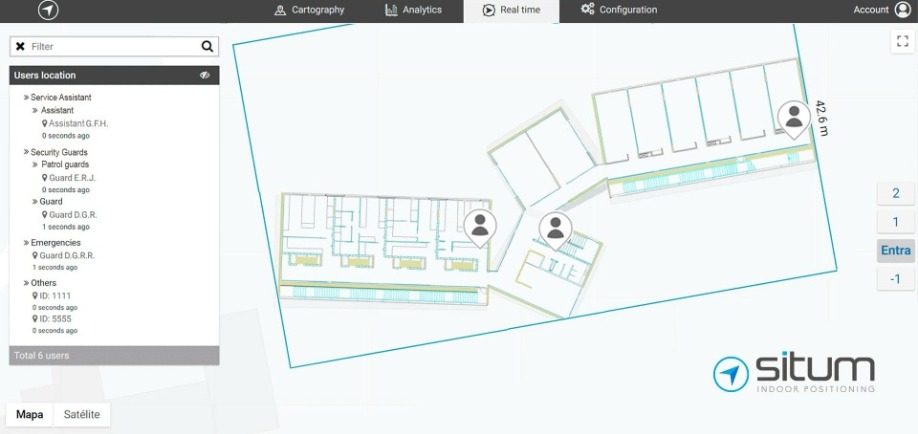
Security staff can monitor the movements of security guards in order to optimise them
“Let’s assume I am managing a warehouse of furniture materials with constant deliveries and sendings. Can Situm do something here?”
Yes. Internal logistics can account for sometimes half of total manufacturing costs for SMEs. When managing a fleet of 10 or more forklift trucks, it becomes more challenging to make sure all of them are always circulating and if possible loaded. An indoor positioning system can help forklift trucks locate the closest urgent package before indicating the most efficient route towards the place to drop it.
In addition to the examples mentioned previously, indoor positioning can become a crucial resource for public hospitals, clinics and field hospitals when it comes to
fighting against a global epidemic as it is the case now.
Real-time indoor geolocation powered by Situm’s application can help orienting doctors and nurses rapidly in case some patients need immediate attention. Medical staff is also able to visualise where incidents are taking place and see what is the quickest route to get there.
This is not a trivial functionality in buildings that are generally the size of several football pitches and are made up of a maze of corridors and rooms. By way of illustration, Madrid’s hospital Universitario La Paz is 30,000 m², that is more than four times the dimensions of the Santiago Bernabéu stadium.
Besides, the Situm application also includes a “panic button”. This means that a worker can request assistance if ever an emergency situation occurs and that he or she cannot deal alone with it. A simple tap on the smartphone is enough to indicate the exact point where help is needed.
On 23 March 2020, Situm announced that they will be providing for free its solution to manage teams through indoor geolocation in field hospitals, hotels, fairgrounds and other temporary structures conditioned to assist during the pandemic. Site managers can contact covid19@situm.com to make their request and use the solution without any licensing costs.
Yet, the relevance of Situm’s solution doesn’t explain alone its success. Its growth was indeed not without some struggle.
A first challenge was to make the indoor positioning technology scalable. This criterion refers to the capacity of handling a growing number of users without having to proportionally increase the resources and still delivering the same performance. The key to scalability in the case of Situm was to be a close-to-100% software company. Previous indoor positioning technologies relied on large hardware investments. Situm, on the contrary, relies on a novel and proprietary indoor positioning software with small hardware investments.
Another obstacle lied in defining what would be the main markets. Expanding abroad may appear tempting but what about additional costs that stem from tariff duties and product customisation for the new market? In this respect, what Situm did was to rely on highly specialised partners that have the knowledge, resources and teams in the countries where Situm has been expanding its business.
Finally, another hurdle that Situm faced was to grow rapidly some crucial areas for the company. To that extent, management quickly took the decision to create two offices with different purposes: a technical one, full of talents, in Galicia in the north-west of Spain where the company was born, and a commercial one in Madrid, a more relevant place to close business deals.
On its quest for growth, Situm was also accompanied the IMPACT Connected Car acceleration programme that helped in many of the aforementioned aspects by for instance:
● Offering technical mentoring in order to develop the technology in a more scalable way.
● Assessing internationalisation readiness with the support of specialised consultants and identifying what were the most promising markets with respect to Situm’s strengths.
● Providing direct and indirect financial support to grow the team, by giving equity-free funding and connecting with VCs.
What if you just started to work in the headquarters of a multinational and that meeting room B-12 is just unfindable on floor 9? Or was it floor 12? Damn.
What if going to buy a new laptop to FNAC you can’t find the comics section where your kid told you he would be while you make your purchase?
What if your apartment is so big that you are discovering new rooms and losing your way to the kitchen every day?
Right, maybe not the last one unless you are Indian billionaire Mukesh Ambani living in an 37,000 m² building.
Nonetheless, leisure, work, health and transportation infrastructures are a more and more essential part of our life experiences. For this reason, indoor positioning is becoming a growing stake and will have to take up various challenges in the years to come to make its concept even more reliable. That includes in particular:
● High-precision: A 3-metre difference can make a lot of difference in a building. A floor difference for instance.
● Minimal infrastructure: Ideally, building owners would hardly require to install anything (sensors etc.) to deliver great geolocation performance.
Does indoor positioning still withhold any secret for you? Now that the way forward is clear, hurry up, your plane is to depart in 10 minutes!

As smart cities continue to gain momentum, the speed and standard at which driverless vehicles – and the supporting infrastructure – are developed and deployed will be one of the tests for making the world’s leading cities fit for future mobility. As such, the need for the automotive industry and infrastructure providers to work closely together has never been more critical in making connected and automated mobility (CAM) a reality, says Rob Capaldi, Commercial Manager for connected and autonomous vehicles (CAV) at HORIBA MIRA.
Smart city initiatives are developing at a rapid pace around the world in a bid to improve every aspect of our lives – from how our power and water supply networks make use of smart metering, to incorporating the Internet of Everything into waste management systems, schools, and hospitals.
Within this vision of smarter and connected cities, there’s no doubt of the key role mobility will play – the concept of CAM considers the movement of people and how to improve every component of a journey by connecting autonomous vehicles with the enabling infrastructure.
The UK government has set in place plans to be a frontrunner in the development and commercialisation of CAVs. It aims to have CAVs on the roads by 2021(1) and it’s not hard to understand why – it’s estimated the UK market for connected and automated vehicles will be worth £52bn by 2035 (2).
But it’s not just the UK’s ambition; governments around the world have committed to increasing the number of journeys made by self-driving vehicles in order to improve safety, reduce the cost of transportation and increase the efficiency of mobility.
This global shift in mobility presents both challenges and opportunities for industry. It’s clear that in order to keep pace with this evolution, a collaborative approach is required.
Collaboration is Key
The implementation of self-driving technology represents a multi-sector challenge, requiring seamless interaction between infrastructure and vehicles. This was highlighted by Zenzic in the UK Connected and Automated Mobility Roadmap to 2030.
The roadmap sets out realistic targets to achieve widespread CAV adoption and states that collaboration between the public and private sector is the only way to make this a reality. It further reveals that if all the activity in the roadmap is carried out in silos and without a coordinated approach, it would take until 2079 for the UK to benefit from self-driving vehicles on the roads.
When it comes to collaboration, our extensive work in the development, verification and validation of CAVs has raised one pressing issue; the need for greater communication and partnerships with those that are developing the vehicles of the future – the automotive manufacturers and suppliers – and those that are managing the infrastructure for such vehicles to be deployed upon – often highways agencies, city planners and civil engineers.
Undeniably, the greater communication between these two sectors is vital not only in minimising the length of time it takes to deploy the first generation of publicly road-worthy CAVs but also in terms of sharing best practice and developing a joint framework that ensures such vehicles meet the highest standard of safety.
Policy and Regulation
To enable self-driving and reap the rewards it will inevitably bring, infrastructure providers must ensure they have a forward-thinking policy and regulatory framework that promotes and accommodates trials of CAV technology.
The UK is already a world leader in this area, in 2019 having updated their Code of Practice for automated vehicle trialling. The updates make it easier for OEMs and other technology firms working in this area to carry out on-road trials. The code of practice has been created to support and facilitate the safe development and introduction of CAV technologies to the UK’s roads, speeding up the public acceptance of CAVs.
Let’s Hit the Road
As the test and trial of automated vehicle technologies reaches record levels, the need has never been more vital to ensure connected and autonomous vehicles are safe, functionally correct and secure.
Many deployments of self-driving shuttles on public roads have been in relatively limited, geo-fenced locations where the experience that’s delivered is pleasant and convenient but ultimately rather limited.
To truly understand and benchmark the capabilities of CAVs, infrastructure authorities must accommodate and encourage further trials and testing in busy urban environments, as well as on streets where multiple user types are not segregated.
With many cities around the world already piloting their own set of CAV trials, developing a best practice approach to trialling that can be replicated anywhere in the world, and which includes a range of complex driving scenarios, is essential. Indeed, before embarking on real-world public road trials, which are inherently complex, it’s important to consider independent safety assessments by clearly defining trial and deployment functional and safety requirements.
Furthermore, when it comes to testing and trialling activity, we cannot overlook the major role that simulation now plays. Highly automated vehicles capable of completing an entire end-to-end journey will require billions of miles of validation before deployment on the roads, a way to achieve this will be through the combination of virtual and physical testing. Developing physical and virtual testbeds for autonomous vehicles should be an essential priority for the automotive industry and infrastructure providers alike.
Go with the Communication Flow
As already mentioned, infrastructure providers must work closely with the automotive industry to ensure that the roads, highways and wider environment are being developed to adequately support autonomous mobility.
Almost every automotive manufacturer, taxi service providers and many tech start-ups have entered the self-driving arena over the last decade, meaning untold advances and technology innovation by many are progressing independent of infrastructure upgrades. Many are developing their autonomous vehicles based on sensing technology such as LIDAR, radar and cameras.
Meanwhile, many predict that autonomous vehicles will eventually be able to navigate safely down the road, avoiding hazards while path-planning to minimise congestion using data provided by the local authorities.
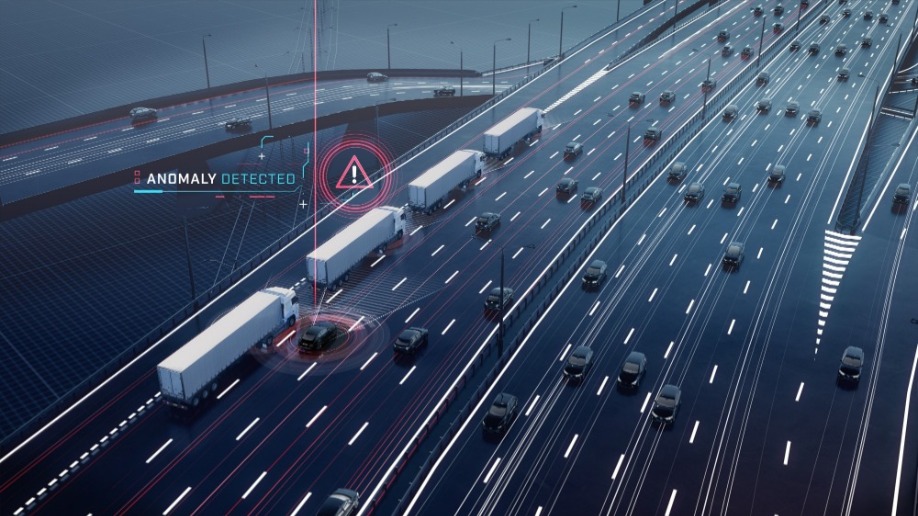
The data is likely to be collected by advanced vehicle to infrastructure communication systems with individual vehicles viewed as ‘data points’ within the road network and from advanced vehicle monitoring systems.
While sensing data will certainly have its place, in a highly connected city, the hope is that it will be used in conjunction with powerful communications technology where the vehicle will eventually be able to connect and learn from other vehicles.
To successfully progress this level of connectivity and interaction between vehicles and infrastructure, the automotive industry needs to consider the communication technology, while the infrastructure sector must make clear how transport infrastructure will align with emerging vehicle technologies.
In practical terms, it may be a case of automakers testing and trialling CAVs using simulation that includes the latest upgrades to communications and physical infrastructure while for the infrastructure sector, simulation can ensure any trialling activity is strategic in the context of what impact it will have on CAVs.
Making Waves on Smart Cities
Amid predictions that spending on smart cities will reach £151.5bn by 2023(2), there is no doubt that advanced mobility projects will represent a large portion of this, bringing clear benefits to society through advances in personal mobility.
To truly take advantage of this opportunity, new ways of working for both the infrastructure and automotive sectors will be required, with an increasing need to come together with a more coordinated approach if connected and autonomous mobility is to become a reality.
As a global provider of pioneering engineering, research and test services, HORIBA MIRA has extensive experience working with the infrastructure and automotive industries in many leading projects in the CAM field. These include creating roadmaps, consulting on quality and safety regulations, providing guidance on infrastructure requirements as well as conducting physical and simulated trials.
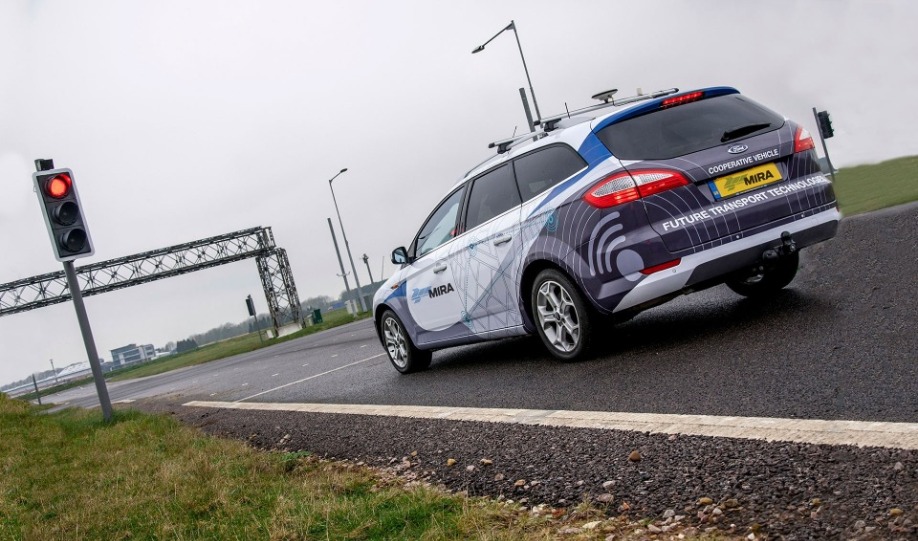
A TALE OF TWO SMART CITIES
There are already some strong real-world case studies where collaboration between infrastructure and the automotive sector is working, with significant input from HORIBA MIRA. November 2018 saw the successful completion of the UK Connected Intelligent Transport Environment (UK CITE) project, a 30-month government and industry co-investment to create an advanced environment for testing connected and autonomous vehicles on the public roads.
It involved equipping over 40 miles of urban roads, dual-carriageways and strategic highways in Coventry and Warwickshire (M40, M42, A45 and A46) with combinations of three vehicle to infrastructure communications methods, and track testing for a fourth, known as LTE-V. The project set out to establish how these communications technologies on public roads can improve journeys, reduce traffic congestion, and provide entertainment and safety services through better connectivity.
UK Autodrive was another ground-breaking three-year collaboration that explored the use of infrastructure and autonomous and semi-autonomous technology on public roads in Coventry and Milton Keynes. As well as developing self-driving technology, UK Autodrive, which completed at the end of 2018, set out to explore the use of car-to-car and car-to-infrastructure communications in order to understand the impact of CAV technology on public acceptance and perception of the technology. It also looked to gather an understanding of legislative and insurance implications.
1 http://new.whatmobile.net/driverless-cars-will-be-on-uk-roads-by-2021/
2 https://www.bbc.co.uk/news/technology-47144449
3 https://www.governmenteuropa.eu/smart-city-spending/93835/
The world is facing a potential crisis greater and more far reaching into our human, natural and physical world than public health pandemics. Environmental change involves air quality, greenhouse gas emissions, and resource use and waste streams associated with growing consumption, and is pervasive across our societies. With much of the world still to experience the level of development that readers of this magazine enjoy, it is worrying that such issues could get worse before they get better. However, wherever people live, they will be affected somehow by environmental change.
How we get around is central to how we live, where we work, what we do to enjoy our lives, and the services we can access. However, as recent events have shown, we are not locked-in to particular mobility patterns or choices, even though this has been perpetuated for many years. There is the opportunity to reduce the huge negative impact from transport, and to accentuate the many positives of travelling sustainably. For this to be happen, we need to refresh our transport methods, so that they are clean - reducing emissions in use as well as production and disposal, smart - being easy to use and managed intelligently in a way that reduces their impact, and efficient - through good use of the space that is used and occupied whilst travelling and stationary. This article outlines these principles and the role of projects such as ‘GreenCharge’ in taking this agenda forward.
Clean
The most obvious, but not only, impact of mobility is what you see in front of you, often in exhaust gases. Fuels used to transport vehicles and goods have varied marginally over the years, but have invariably involved some form of internal combustion carried out on the move, with the pollution directly emitted wherever the vehicles – cars, buses, trains – happen to be.
The alternative vision, from projects like GreenCharge, is a system where energy is produced more sustainably, and on the move emissions from direct propulsion are reduced (albeit road and brake dust emissions remain, but we will save that for another article).
Converting vehicles to electric power still means energy has to come from somewhere. Simply replacing mobile fossil fuel combustion with electricity from fossil fuelled power stations is not the answer. This is why we need renewable energy: ideally locally produced, available for mobility, and managed successfully alongside demands such as for domestic and industrial needs. This is a huge challenge, and greater than it might at first seem. Where does this energy come from? Who pays for it? How is it managed? Who gets to access it? Who benefits from its production?
In other words, renewable energy needs to be at the core of transport discussions in the future - challenging the mutual knowledge of different sectors and professions that speak different languages and have completely different complexes. However, luckily mobility is very flexible. Providing that an electric motor is available, it is versatile to any reasonable and reliable source of energy. The most obvious is solar power, followed by wind power. Both of these sources can be provided remotely (e.g. wind farms around Bremen, Germany), and/or locally (e.g. solar panels above parking garages in Oslo, Norway). It can even be supported by existing energy mixes on the grid, which may be more or less sustainable in the short to medium term, as the “energy transition” plays out.
Picture: Solar panels for electric mobility on top of an apartment block in Oslo, Norway. Photo: City of Oslo
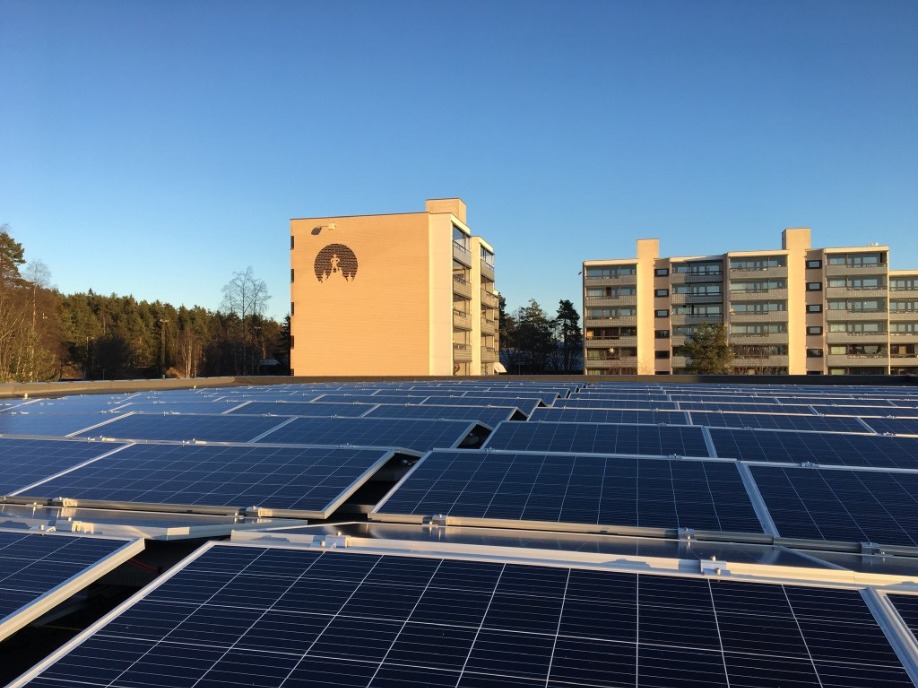
Smart
We also need to consider new patterns of fuelling, or charging. At home? At work? Or still on the move like traditional petrol/service stations or something more local. And related to this, what time of the day does this need to happen – and can this be malleable so the demand for energy is a more harmonious match with the pattern of energy supply.
It should be clear that energy is not infinite, and for many reasons it would not be desirable for that to be the case. So, we cannot design mobility systems that envisage an unrealistic supply of energy, and in turn cannot design energy systems that have excess capacity most of the time to cater only for peaks in charging demand as people plug in all at once. We want to understand how we can balance these needs by engaging consumers in a relationship with the energy they use, i.e. understanding the need to make “smart” decisions about when, and how much, they charge their vehicles.
Projects such as GreenCharge are looking at how “booking” can be assigned to charging. This dynamically and intelligently assigns slots for an amount of energy to be provided to vehicles, potentially based on need, potentially based on price. Not everyone needs their car to be fully charged as soon as they get home; if this happens as soon as people plug it in, it can lead to peaks in demand. This can be easily resolved by phasing of charging over a longer period of time (e.g. overnight). This requires some understanding so individuals can make decisions, and also so they can accept it when software also intervenes to manage this for them.
“Fill Her Up” is antiquated, but people may still be used to the reassurance that a “full tank of fuel” provides. Parking garages, for example catering for hundreds of apartments, are a situation where particularly acute pressures can arise on the local grid if we are to meet our targets for electric vehicle ownership; already around 80 percent of vehicles sold in Oslo are electric, so solving this problem of charging cost-effectively needs to come quickly - and be ready for when other cities and countries catch up.
Smart energy management can be ideally extended further, to help even out the pattern of energy demanded by householders across all their discretionary activities – so everyday activities such as washing the clothes and dishes, and even levels of heating, can be balanced across not only one household, but across a neighbourhood. This relies on some level of public acceptance of such interventions, currently uncertain, but also technologies being available and built-in which can manage our devices transparently on our behalf (the ‘internet of things’). “Smart plugs” have been fitted to household appliances in experiments for this concept, but it has yet to enter the mainstream in most people’s lives.
It is clear that in many neighbourhoods there is simply not the capacity in the local grid to power up everyone’s personal mobility needs, and to charge the vast number of vehicles targeted in the plans of cities to transform vehicle ownership towards electric models. Energy exchange systems, such as vehicle to vehicle, vehicle to grid, and vehicle to everything else systems, add a further layer of future complexity or opportunity, dependent on your perspective.
Efficient
A fundamental means of reducing the environmental impacts of travel is simply – not to travel. Or, preferably, to reduce distances travelled, both by people and by goods. Recent events have exposed our vulnerability and reliance on medium to long distance travel, with long commutes that have arisen through many years of increasing property prices near places of work, and longer supply chains in the search for ever cheaper goods. We must continue to make sure occupancies of passenger and freight vehicles are maximised – this has probably been overly successfully achieved, with overcrowding and tight spacing of seating and standing on many forms of public transport; again, this is a challenge to deal with in a future of social distancing, and in particular journey sharing to increase occupancies by car is likely to cause a worry for some, as people may revert to solo modes of travel, such as the car (or preferably active travel such as cycling and walking).
But it is not all about the car.
There are certainly many people who are against electric mobility because of a perception that it gives the car industry a reason to perpetuate its market for increased car use, and lets drivers off the moral environmental hook. And they have a point.
This is why it is important that not only cars are considered in this equation. In fact, other forms of electric transport are growing at a much faster rate than car purchases, which may be surprising given our image of the sector can be heavily influenced by the mighty marketing budgets of car and vehicle manufacturers, as they look to protect a market segment and secure new “eco-friendly” sales opportunities. Huge marketing budgets tell us that electric cars are the mobility of the future. But changing the energy source will not solve their negative contribution in terms of the land demanded for using and storing them, in terms of public health through sedentary travel experiences and injuries and deaths through accidents, and neither is likely to be solved by an autonomous future. Cars are largely big, relatively expensive to buy and cater for, and can appear to dominate our cities and transport systems. Or do they?
In fact, what we see in countries such as France is that electric bicycle sales outstripped electric car sales by 10:1. In 2019, well over one million electric bikes were sold in 2019 compared to barely sixty thousand electric cars. Lighter (and ideally shared access) vehicles for single person transport are clearly a means to achieve efficiency, in terms of both their space and weight, and have a great role to play. Aided by electric motor and batteries, ebikes have opened up a whole new world of opportunities for both personal and cargo transport within and in between our villages, towns and cities, in a way that is proving much faster and in-step with modern transport planning expectations than large, heavy, fossil-fuelled vehicles. Shared electric scooters, mopeds and electric bikes (such as in the city of Barcelona, Spain) have evolved from a bubble of shared bike systems, and have become an established part of the urban landscape in most ‘premier league’ cities.
However, they have not always spread successfully or at all to be universally available suburban areas, smaller towns or rural areas, where innovation away from the dominance of car use can still mean something altogether different and more basic. The business models have failed to emerge in these areas, and indeed many city centre systems run at a financial loss or require subsidy; many progressive cities would see this as an investment, but systems must be made inclusive to be deserving of this.
Picture: Electric bicycle charging in Barcelona. Photo: Enchufing/Eurecat
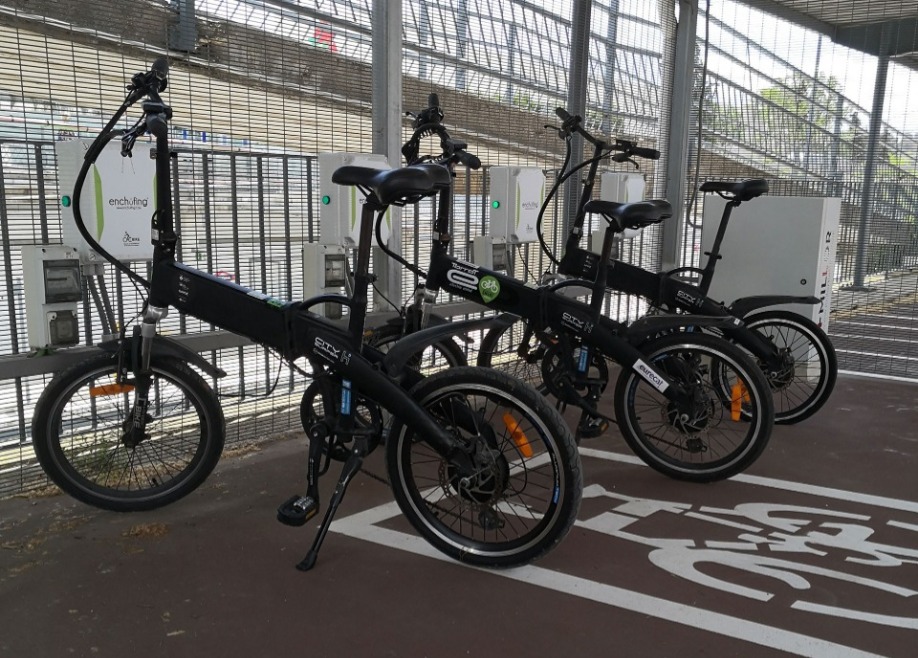
And, of course, we mustn’t overlook that many of our medium and longer distance transport modes (such as trains, trams, undergrounds) have been pioneers of electric propulsion for many years, and electric buses have a big role to play in driving down particulate pollution in our cities; Chinese cities such as Shanghai are successfully showing Europe the way forward in this regard.
Photo: Electric buses in Shanghai. Photo: Author
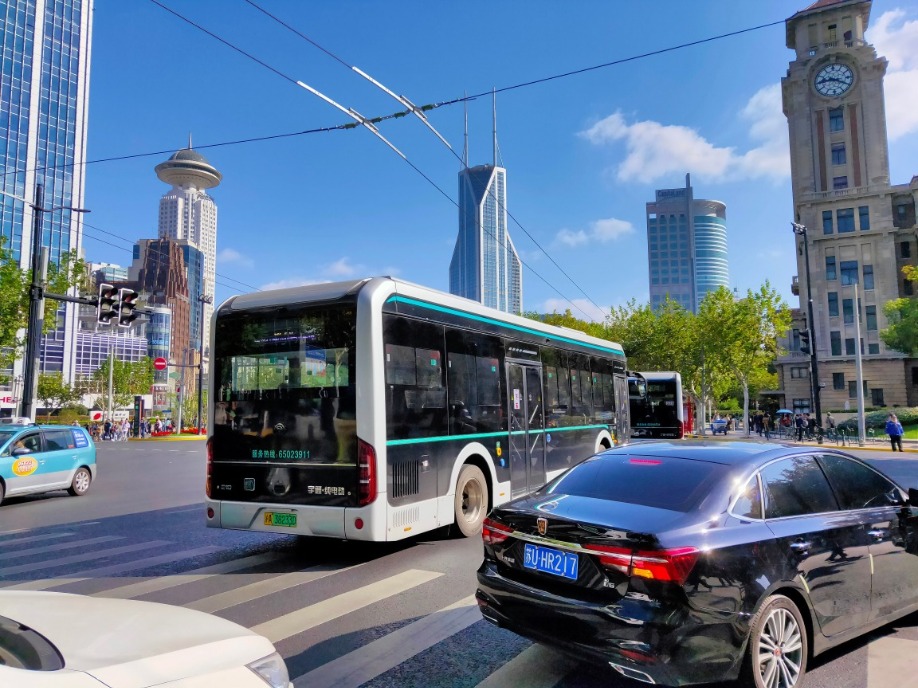
Mobility as a Service (MaaS) has become the latest catchphrase for integrated transport, but has yet to prove itself convincingly away from some limited cities, such as London, where the necessary basics (information, fares, connections) were embraced long before the term was even coined. These goals have been chased for many years by the public sector and now followed by the private sector, but only achieved partially in a number of examples and not always embracing the full range of modal opportunities from active, shared, public and collective transport in one common and socially-responsible mobility solution.
GreenCharge
GreenCharge is a Horizon 2020 project funded by the European Commission, in which electric mobility is funded in the three cities of Barcelona (Spain), Bremen (Germany), and Oslo (Norway),. GreenCharge has three key goals.
● Power to the People - making sure that people that depend on using electric vehicles can be sure that they are adequately charged when they want to travel. The “traditional”, simple view of that means that people should be able to find a free charging point, plug in and charge – whenever they want to. In GreenCharge we take a more nuanced view: the vehicle should be adequately charged at the moment they wish to travel. And that is not necessarily the same as the moment they park their vehicle.
● A Delicate Balance of Power - There is a reason that the word “Green” is in the title: to maximise the use of “green” energy. As communities start to make use of local energy production from sun, wind etc., the availability of locally produced ”green” energy will increase. The Energy Smart Neighbourhoods concept is about balancing all this out so that local batteries can be used as a buffer, energy demands can be moved to different time slots, and all of this can be controlled by ”smart” software (also taking account of other factors such as temperature forecasts)
● Money Makes the World Go Round (even though motors turn wheels) - The smartest technical solutions in the world will get nowhere if the different stakeholders involved in their use do not have appropriate financial and other incentives. “What’s in it for me?” GreenCharge develops business models that can be applied in a range of settings and electric transport modes.
GreenCharge runs pilot projects in Barcelona, Bremen and Oslo, cities which have different needs for transportation and the penetration of electric vehicles. Together they express a variety of needs in the full transition towards electric mobility. In Barcelona, there is a specific focus on light vehicles including electric bikes and scooters, battery swapping and workplace charging. In Bremen, the focus is on promoting electric vehicle sharing, and use of local batteries and renewable energy to balance peak energy demands. In Oslo, the focus is on cost-efficient and balanced home charging for apartment residents, and the booking of charging.
Picture: Electric mobility through neighbourhood car sharing in Bremen, Germany. Photo: City of Bremen
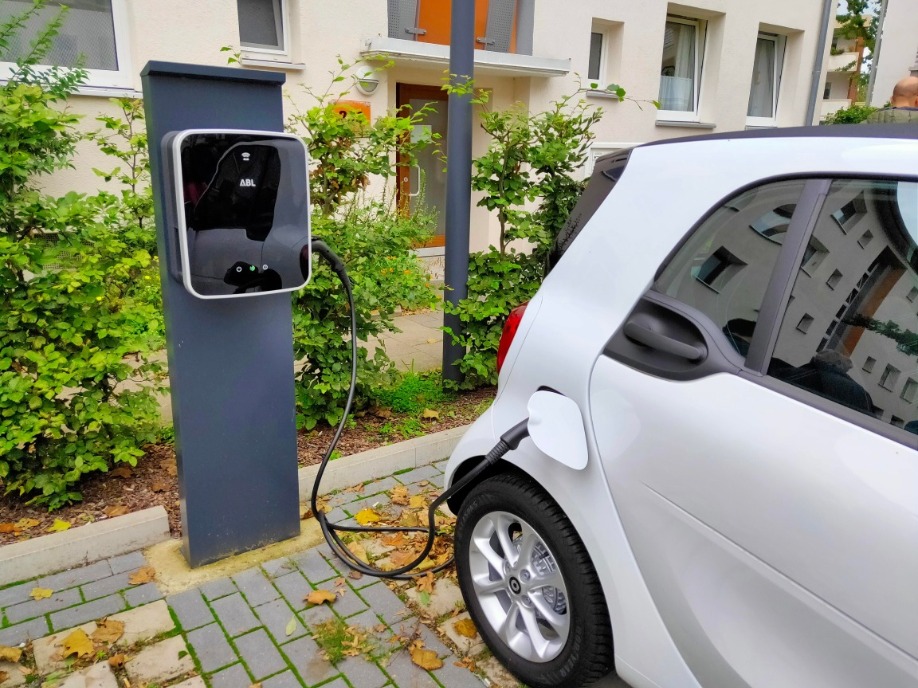
Known Unknowns
To be truthful, we do not know all about or regularly account for all the important impacts of the electric mobility journey. The materials for batteries such as cobalt and lithium, or their future alternatives, bring both social and environmental concerns in their exploitation, as many of the countries where these are sourced from,are often in political and social transition. It is also likely that within the space of five to ten years, we will need to find alternative uses or disposal routes for today’s batteries and electric vehicle technologies as part of a ‘circular economy’. Batteries that have exceeded their useful lives for mobility can still find use in energy storage in homes, and this is already being applied from old car batteries in Bremen and old bus batteries in Stockholm.
However, regulation and potentially standardisation may be needed to ensure designs and technologies can be refitted; there has already emerged a wide range of batteries and charging interfaces.
A balanced multi-modal future
Firstly, as mentioned above, we need to counter the perception that electric mobility is all about the car. Part of this work involves ensuring that investment in charging infrastructure is balanced across all modes. Car-based charging is expensive, energy intensive, and can be seen to support car use - so it is even better to provide charging for both cars, bikes and other micromobility modes at one station. There are limited examples in the market place and even fewer examples on the street, and this needs to change so that all electric modes benefit from flexibility and freedom in their use.
Good examples include the Bosch Power Stations in tourist areas of France, where dedicated charging units exist for ebike users at cafes and other midway destinations, and some Aldi stores in Germany, which offer ebike charging through renewable energy. Companies such as IKEA also clearly recognise the need to link renewable energy with mobility in their next strategic steps. Housing developers, providers and cooperatives also need to embrace their role, alongside employers, in their role as transport planners in enabling electric travel choices through charging and energy harvesting infrastructure.
Secondly, we need to truly integrate renewable energy into the electric mobility mix. Ideally this is locally produced, at a small scale to put consumers in touch with their energy needs and potentially becoming self-sufficient or even “prosumers” who produce and consume energy and make a profit in doing so. Energy losses in transmission are also reduced through local generation of power, and energy security issues from long distance energy sources less of an immediate concern.
Thirdly, we need to generate the appetite for smart energy management. Considering others’ energy demands in our own lives and choices is something most people are not accustomed to, but could be how we all need to live in the future. The lights don’t go out in most advanced European countries anymore, but we should not be complacent in our actions to ensure we do not lead ourselves into this happening in the future. Engendering collective responsibility and altruism through preventative action has historically been difficult, and we are more tuned to dealing with crisis when crisis comes.
And lastly, urban planning needs to respond to the challenge. This can be through low emission zones, space for cycling, charging facilities for all modes of transport, as well as a structure of incentives that encourage people to adopt electric vehicle habits.
The vision of GreenCharge is an all-electric mobile future where charging is easily available to everyone, charging uses renewable energy, and charging infrastructure is not dependent on major investments in the power grid.
If we succeed, we will all have a quieter, cleaner and healthier environment to live in – which can only be of benefit to everyone.
Through ICLEI Europe based in Freiburg, Germany, the author is supported by the GreenCharge project which has received funding from the European Union’s Horizon 2020 research and innovation programme under grant agreement No 769016 and forms part of the CIVITAS Initiative. GreenCharge is coordinated by SINTEF in Trondheim, Norway, and full details can be found on its website www.greencharge2020.eu and via Twitter @GreenCharge2020
Reggie Tricker
By Akhil Aryan, Co-Founder & CEO at ION Energy, one of the world’s most advanced battery management and intelligence platform. Accelerating Earth's transition to an all-electric planet, ION leverages advanced electronics and software to improve the life and performance of lithium-ion batteries used in electric vehicles and energy storage systems.
The EV and clean fuel lobby in the past years have promoted a sustainable, eco-friendly and fuel-efficient mode of transport and to tackle the ongoing pollution and climate crisis. And now in the year 2020, who could have known that these forecasts made by the EV experts and scientists would manifest in the shape of the COVID-19 pandemic, and that too in a limited time. As we’ve lost countless lives to the pandemic and face economic losses accruing over trillions of dollars, in a report released by the United Nations, it is high time that world governments wake up to the imminent and the inevitable.
Almost the entire world is locked up as of now with all business activities and gatherings being indefinitely disbanded.. While on the plus side, with transport systems and factories shut down in most parts of the world, the biosphere is indeed breathing free after a long time. The flora and fauna too is blooming, as suddenly the wildlife finds itself free and unperturbed with humans confined to their residences.
The Future Course
The impact of COVID-19 on the emerging EV and EV infrastructure market will understandably result in the sector taking a backseat across the world. When in time the world does heal itself from COVID-19, it is absolutely essential to etch out a future roadmap that uncompromisingly stresses on cleaner, renewable and planet-friendly technologies for all human activities and endeavors. The disease has unbelievably enough, morphed from an epidemic outbreak to a pandemic of catastrophic proportions in a very little time.
The Problem Multiplication
Transitioning to proficient and renewable sources of energy and curtailing the greenhouse gas emissions were of the utmost importance as efforts were being made all across the globe to realize the same. It was all going as per the intended blueprint, until 2020 dawned dragging a pandemic in its wake. With all infrastructural and research development plans pertaining to EV maximization brought to a standstill, many countries in the world are now left with little option but to initiate excessive damage-control measures and preemptive actions to fight the pandemic.
Absolute Necessity
Even in the post-corona landscape, ushering an immediate and worldwide shift to EV technology would be a need of the highest order. The EV engines powered by state-of-the-art lithium ion and cobalt batteries have drastically reduced the relentless CO2 emission by ICEs. They have also helped in preserving the ever-depleting natural fuel reserves by curbing our incessant energy reliance on fossilized sources such as petrol and gas. It is proving to become a win-win situation especially in the long-run, both ecologically and economically.
Stepping up
Factors such as various governments of the world witness a rise in sensitivity towards a cleaner environment, the surge in vehicle range per charge for electric vehicles, tech-advancements in EV charging and significant investments from automotive players and entrepreneurs are leveraging the rise of the global electric vehicles and its infrastructure market. Such key aspects are set to considerably pivot the emergence of a thriving and expansive EV ecosystem in the near future.
There’s Good news too
Although China is the leading developer and contributor to the largest EV market in the world followed by Europe and the US, the coronavirus crisis has decelerated the further development of the extant thriving EV sector in China and the resultant economic growth. Still, owing to the leading position of China in terms of the biggest EV market in the world, thus Asia Oceania is posed to emerge as the market leader during the forecast period and is expected to become the largest electric vehicle market by 2021. Due to the rising demand for greener and cleaner vehicular mobility along with several initiatives ushered by private organizations and governments, the world is slated to improve its existing EV infrastructure with a plethora of developed and developing economies driving the change.
The Drivers
The governments of developing economies such as India, Brazil, and South Africa, etc. have taken into cognizance the undeniable growth potential of the electric vehicle market, and hence, have undertaken various initiatives to attract OEMs to manufacture and develop EV batteries in domestic markets. It is an important step towards realizing the EV aspirations for any country as the LI-ion battery accounts for almost 45% of the total cost of an EV vehicle. In March 2019, the Indian government launched the second phase of FAME – II, which includes establishing around 2,700 charging stations in the metropolitan cities of the country.
Also, the Indian government has mandated cab-hailing companies such as Ola and Uber to have 40% of their fleet as electric vehicles as a necessary step to boost the EV realm in the country. Many state governments supported by the center too have announced various incentives and subsidies for EV purveyors and owners of electric fleets. The authorities have also initiated various monetary inducements for companies that are involved in the development and up-scaling of the EV paradigm in India.
Japan to the Rescue
Irrespective of the earth-shattering brunt of COVID-19, the EV charging infrastructure in Japan is handsomely seated at an advanced and highly-developed phase with more and more EV sales and electric vehicle charging stations market expected to grow extensively in the upcoming future. Such a slew of complementary factors will compel the growth and expansion of the EV market in the Asia Oceania region.
The operations of some crucial EV manufacturing companies such as Nissan Motor Co., KIA Motors Corp., BMW AG, Nissan Motor Co., Daimler AG, and Tesla, Inc have been duly affected by the coronavirus epidemic. In the event of such a disaster, most of these automobile companies have demobilized their automobile production facilities and switched their focus towards the manufacturing of personal protective equipment.
As much of the world automobile sector has hitherto depended on China as a manufacturing base, the various automotive players have experienced severe supply disruptions during the last few months. Moreover owing to the spreading of the virus from the epicenter in China and its unfeasible economic and foreign policies, automakers are set to revise their erstwhile supplier strategy across geographies, and are posited to depend more on indigenous and less-controversial suppliers. Japan has even allocated US$2.2 billion to assist companies in shifting their manufacturing base from China to Japan. It has also assigned a sum of US$214 million to other countries who wish to shift their base of production from China to other nations.
While the world is seemingly in a state of shock and attempts to accept reality, there is always hope for things to turn out better provided the whole of humanity comes together in a holistic and cooperative effort. The world needs to wake up to all the fault-lines in past policies while breaking away from the extant disastrous patterns of folly and must exercise coercive action at the earliest. The COVID-19 catastrophe has taught humanity a valuable lesson in caring about the environment and becoming ecologically aware. Heralding an all-electric EV transition along with other bio-friendly and feasible technologies across the world should be the foremost priority of governments across the globe to ensure a better and sustainable future.
Nearly all of us have had a hard re-set of our travel habits over the last couple of months. The pandemic lockdown has completely changed how most of us work, study, spend our leisure time and interact with each other. Travel by bus, train and private car is down between 80 and 95% depending on mode, point in time and exact location. Cycling is up, in some areas by as much as 70%, and so is walking. We have heard a DfT Minister urge us to use private cars for travel and avoid public transport if at all possible. This instruction would have seemed outlandish at any time between the 1980s and now, but makes perfect sense in our present situation.
As well as the tragedies directly caused by the COVID-19 pandemic, the necessary restrictions placed on us are causing severe economic damage, unprecedented loneliness and danger to mental health, serious disruption to education at all levels, and will probably finally finish off traditional high street shopping and start a similar decline in the value of commercial property, as the concept of the large city centre HQ office takes a severe credibility knock.
But there are positive effects: the downturn in traffic and all motorised travel brings air quality, noise and safety benefits, and the suspension of “going to work” for many has given weekly time gains of up to 15 hours for the most long-distance commuters. Not everybody is able to stop travelling to work, and those who have continued to do so have benefited from less overcrowding and more predictable journeys as congestion ceases to affect car and bus travel. Cycling and walking bring both physical and mental health benefits. There are gains here in terms of reduced pollution, increased road safety (albeit with an unwelcome increase in the small number of extreme speeding offences, quality of life both for those who have reclaimed their usual travel time and those whose essential journeys are more pleasant, and public health benefit from more active travel being undertaken.
It is essential that the transport sector does not now sit back and wait for the post-lockdown scenario to develop and then react to it. Instead, everybody from planners to data specialists must engage in shaping this scenario. What actions should we take now, or recommend for others, so that the benefits we have seen get locked in, while also help to mitigate the negative effects of economic downturn, social isolation and so on?
The previous situation had many flaws; as can be seen from the improvements we see now. The current, lockdown, situation has a whole set of flaws of its own. It is both possible and desirable to build on this and design our transport future, rather than wait for economic and social changes to occur and then react to them.
Both as a society and as individuals we have been made to think hard about what is and is not essential mobility. The movement of freight and of key workers is essential and must be enabled and supported. Travelling to provide support to vulnerable people is also essential. Travelling to a workplace to carry out tasks which can just as easily be undertaken at home is not essential, and neither is going on holiday trips or visiting second homes. But travelling to visit friends and relatives has gained recognition as important by virtue of the unhappiness and even mental health problems caused by it being banned for a long period of time.
We should pay attention to the hierarchy we have had to develop, and translate it into our redesigned transport network. With so much less other traffic on the roads, the easing of restrictions of freight movements have not caused many serious problems. It is also part of our enforced mental reset that we have come to understand that deliveries to shops selling essential items such as food and cleaning materials are important and that to treat them as a public nuisance is not reasonable. Technology can help: systems for booking kerb space and loading areas can be integrated with fleet management systems to ensure that vehicles turn up, do the necessary loading and unloading, and depart with minimum noise, road space occupation, and emissions.
Key workers who cannot work from home must be enabled to travel safely and conveniently. The best contribution to this is for others to stay off the network. But with good data from vehicle loading counters, ticket usage, traffic counting and so on, it is possible to predict very accurately when services and roads will be less busy. Those who must travel can do so with the knowledge of what the best times are, and sensible employment practices should be put in place to enable them to take advantage of this. We may also want to think about how pricing can help to spread the load and enable safer, less congested travel, with flexible public transport fares and flexible road pricing for cars. Some of these measures have been controversial in the past, but our priorities will have changed for the future and the desire to avoid crowded conditions will be with us for the foreseeable future.
The approaches which support necessary travel for work will also function for the “essential leisure travel” described above. Most people do want to spend time with family and friends and the inability to do so for months on end has caused real hardship and cannot be entertained longer term. But with the ability to make informed decisions about when to travel, what route and service to use, these trips become both safer and more pleasant.
The increased use of walking and cycling to get around, both for transport and for leisure, is a boon which governments have desired for a long time. The gradual increase in cycling turned into a spike during lockdown and the benefits of locking that in for the future are many and obvious. While the UK remains a crowded place overall, there should be roadspace for good cycling and walking provision if those who do not need to drive to work, carry on refraining from doing so. There will need to be a lot of infrastructure work to make this happen, not an unwelcome consideration as we consider how to keep as many citizens as possible working and paying tax after the massive expenditure of the lockdown period. Technology can also assist with the usual route planning services – some specific cycle routeing apps are detailed and impressive – but there is scope here for gamification and the carrot rather than stick approach. Competitive walking and cycling can be a lot of fun as many app users know, some people enjoy seeing themselves burning energy in real time, and maybe at some point the NHS will realise that paying us a small amount per mile walked or cycled will actually deliver a budget saving. This suggestion is tongue in cheek but games concepts really are underused for amending travel behaviour.
The pandemic crisis has brought a lot of human suffering and a sharp shock to the economy which sustain us. The challenge to the transport sector is to follow the injunction by Transport Minister Grant Shapps who asked local authorities to “help embed altered behaviours and demonstrate the positive effects of active travel”. At the same time we must contribute to restarting the economy in an environmentally sustainable way and lock in the improvements to quality of life such as less travel for work and more use of active travel modes. In the words of a Malaysian transport official during a recent Zoom call: help to build a better world.
By Jennie Martin - ITS UK
The UK government recently pledged to bring forward a ban on new diesel and petrol car sales from 2040, to 2035. The move surprised some, but perhaps most surprising was the confirmation that the ban will also include hybrid vehicles, which use a combustion engine running on fossil fuel and an electric battery pack.
You might have taken the noise and fumes for granted at roadsides, but the ban would mean that petrol and diesel fuel is eliminated from new passenger vehicles within 15 years. This would have obvious benefits for reducing carbon emissions and improving air quality, but there are significant obstacles for the UK’s car industry to overcome in the meantime.
In 2019, only 1.6% of new passenger vehicles sold were electric vehicles, but they will need to form the majority of sales from 2035. So how can the next decade and a half set Britain on track for zero-carbon car travel?
Read more: Cars will change more in the next decade than they have in the past century
When it comes to designing and building petrol and diesel powered vehicles, the UK has a wealth of talent and expertise. In 2018, the UK produced 2.72 million engines and was the fourth largest car manufacturing country in the EU by total vehicles produced.
If the UK is to retain or grow this £82 billion industry in 2035, much of the existing workforce will need to be retrained in making electric vehicles. A wave of engineering graduates with expertise in electric and autonomous vehicles will also be needed to develop the next generation of electric vehicles.
The good news is that universities and start-ups in the UK are behind world-leading research into new battery technologies. There’s more than one way to power an electric car, and these batteries come in a dizzying variety, from solid-state electrolyte batteries, low cost sodium-ion batteries, and lithium-air batteries which can store much more energy than conventional lithium-ion batteries.
The government is investing £274 million in battery research and manufacturing over four years through the Faraday Challenge. But investment will have to continue well after that to ensure these technologies make the difficult transition from prototype to mass production.
All those electric vehicles will need charging points too, and their increased electricity demand on the national grid will need to be met by renewables. That could amount to over 80 terawatt hours (TWh) – increasing demand by a quarter. New solar farms and wind turbines will need to be built, along with new power lines, substations and rapid charging networks to distribute the electricity. If all of this is to be in place by 2035, action and investment is needed almost immediately.
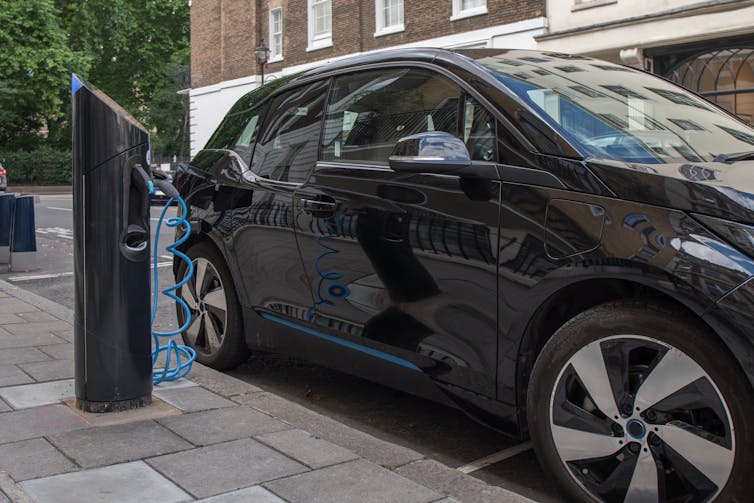
Many electric cars run on lithium-ion batteries, which start to age and lose the amount of electricity they can store from the moment they’re made. This is not so much of a problem in our phones, which have small batteries and are replaced every few years. But when it comes to electric vehicles, the battery pack is typically the most expensive part of the vehicle.
In 2017, the average lifetime of an electric vehicle battery pack was eight years, and only 10-50% of it could be recycled. Targets for 2035 are to have battery packs that last 15 years and are 95% recyclable. Researchers will need to improve the design of these batteries and the cars themselves to achieve this, while the government will have to build facilities that can recycle batteries, separating the raw materials – lithium, cobalt, nickel and carbon – so that they can be reused in the next generation of batteries.
Read more: Lithium is finite – but clean technology relies on such non-renewable resources
Battery electric vehicles aren’t the only solution. Hydrogen fuel cells combine hydrogen and oxygen from the air to produce water, generating electricity. If the hydrogen fuel is produced through electrolysis using renewable energy, then the process can have net zero CO₂ emissions.
Hydrogen fuels cells are less energy efficient than batteries, but the compressed hydrogen tank can be refuelled in less than five minutes and in a similar way to refuelling a petrol or diesel car. This makes hydrogen ideal for vehicles that undertake repeated long-distance journeys and are currently limited by the range and charging times of battery vehicles, such as taxis and transit vans.
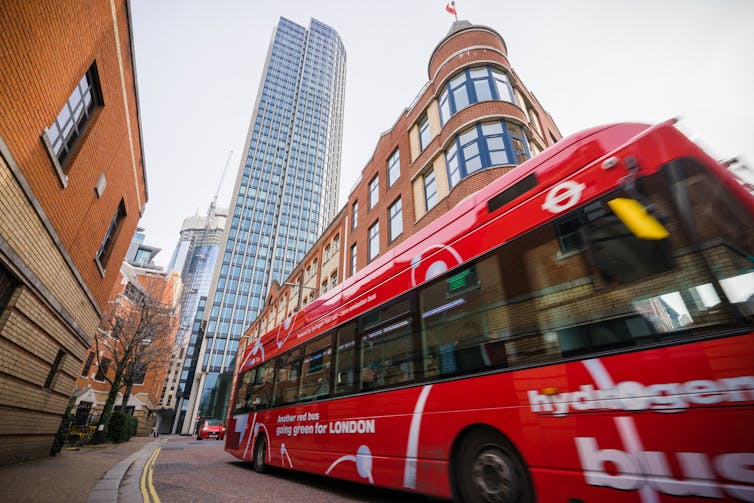
Lorries and buses aren’t covered in the 2035 ban, but hydrogen is also an ideal alternative fuel for them. London has eight hydrogen buses, but there are just 17 hydrogen refuelling stations in the UK, compared with 15,000 electric vehicle charging points. A hydrogen refuelling network is urgently needed to help decarbonise the parts of the UK’s transport network that is hard for electric vehicles to reach.
The common theme across all of these points is investment. If the UK government really intends to meet its ambitious new target, then it will need to invest heavily and soon. If done right, this could reignite the automotive industry and position the UK as a world leader in electric vehicle production.

Ashley Fly, Lecturer in Vehicle Electrification, Loughborough University
This article is republished from The Conversation under a Creative Commons license. Read the original article.
Even in a pandemic, transportation is an essential service. People need to get food and medical supplies, to get to hospitals, to get to work or deliver food, medicine and other critical items. We need the shared economy more than ever right now.
However, social distancing has created some new challenges. Typically, public transit has the highest density of people per square foot, making it an environmentally friendly and economic mode of transportation. But during social distancing and lockdowns, mass transportation becomes hazardous. Some cities have scaled back public transportation services in response to severe declines in ridership. Public transportation is down by 70% in cities with “shelter-in-place” orders or lockdown orders.
Shared mobility, such as carsharing and ridehailing, offer protected spaces where individuals can use vehicles to do allowed tasks such as commute to an essential job or respond to the increased demand for delivery services.
While carsharing can be done in isolation, ridesharing requires interaction with others. In the US, ridesharing companies have ceased to offer pooling services (Uber Pool, Lyft Line) to minimize close contact. In addition, ridehailing demand has plummeted as workers stay home and restaurants and bars close. Uber reported to investors that rides are down 60-70% in hard-hit cities like Seattle and New York.
Ridecell’s own data has shown a drop in shared mobility vehicle utilization across multiple vendors, specifically in “shelter-in-place” locations.
Are shared vehicles a risk or a benefit?
Whether shared mobility is a risk or a benefit depends on where you live. In Paris, carsharing services were shut down. In San Francisco and DC, shared services are deemed an essential service.
Companies like GIG increased regular vehicle cleanings and disinfection and left cleaning supplies including wipes and hand sanitizer in the vehicles for renters to wipe down before and after use.
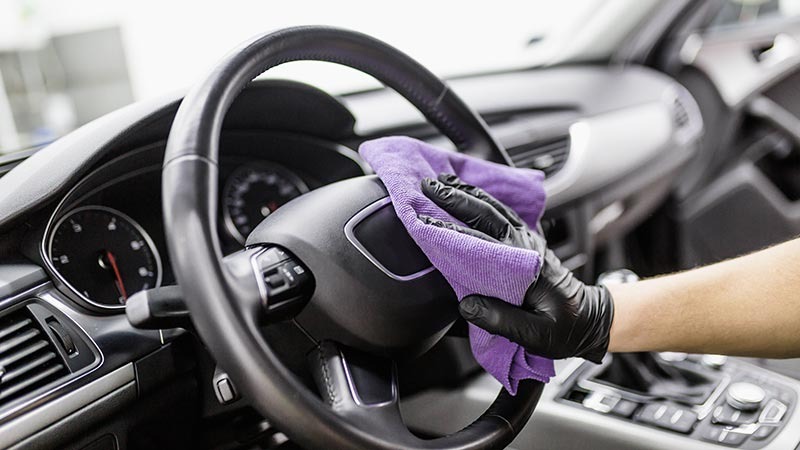
In China, Didi’s ridehailing service is considered essential for transporting healthcare workers. Didi put up plastic barriers between the front and back seats to protect drivers and passengers. Drivers wear protective gear and keep disinfectant on hand to clean cars between each ride. Drivers in the US are starting to rig their own protective devices to combat the spread of the virus while still offering transportation for people who need it.
While Lime has suspended its scooter service in many countries, Voi is attaching gloves to its scooters and Spin is including hand sanitizers for those people who need a scooter to get to essential services.
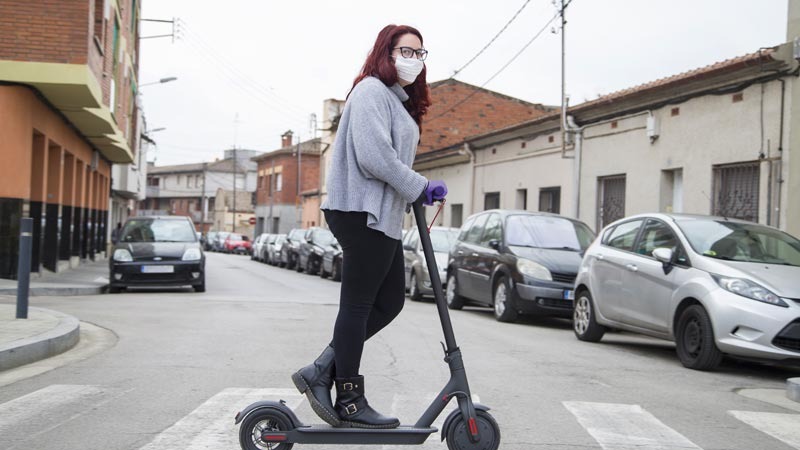
New York has seen a 67% increase in CitiBike rentals during the Coronavirus outbreak. Bikes and bike sharing give people a much-needed break from long hours at home and allow them to get some exercise outdoors in the fresh air. New York’s Mayor has also suspended the city’s eBike crackdown during the outbreak to allow bike messengering and delivery services. The city is even considering adding more bike lanes and taking away vehicle lanes to encourage bike use for the long-term.
For shared mobility companies, having a flexible business model can save your company during the COVID-19 outbreak. For example, Uber is opening UberConnect and UberDirect to offer more delivery services in lieu of rides. Being able to quickly move fleets of cars through cleaning and disinfecting processes or deploying cleaners to the cars as needed is critical to keeping vehicles in service. Making sure the car is not only operational but also has the requisite safety gear such as wipes and masks, means having the ability to predict, respond and deploy maintenance operations quickly and with minimal disruption.
In addition, repurposing inventory for increased demand is key to profitability. If demand during the day is for delivery and errands, use the fleet for carsharing. But if demand at night is for critical care and hospitals, fleets need to adjust accordingly to ridehailing. Offer vehicles to delivery workers during the day and hospitals during the evening.

The Ridecell Platform gives shared mobility companies the data and intelligence they need to stay in business, adjust to changing demand and build customer loyalty for the future. We may have to distance ourselves from others right now, but that doesn’t mean we can’t offer compassion with our rides. As one driver expressed with a sign on his plastic barrier, “Love can still pass through the plastic.”
By Diptii Tiiku - Senior Director of Corporate Marketing, Ridecell
According to the global status report on road safety from the World Health Organization, approximately 1.35 million people died in traffic accidents in 2018, and 3,700 people died in car accidents every day, that’s to say, around 3,700 people died in car accidents every day. Nevertheless, almost all of these injuries and deaths were caused by human error. As one of the most important future technologies in the 21st century, we believe that self-driving cars will effectively eliminate accidents that are caused by human error.
LiDAR is the most important and indispensable part of the environmental perception of autonomous vehicles. It enables robots or vehicles to have perception capability more superior to humans and ensures the safety of future mobility.
Most of the current autonomous driving solutions, due to the limited vertical field of view (FOV) and the vehicle roof-top installation of the LiDAR, have blind-spot areas around the vehicle body which are difficult to be scanned by the LiDAR, and may result in a large number of undetectable dangerous corner cases and objects (such as pets, children, etc.). Today we will introduce three common LiDAR solutions tackling the near-field blind-spot detection.

Image link: https://drive.google.com/open?id=1mJhFzGjfZZ4UN8AEkDymsOAJat41OPt9
Source from the Internet

Image link: https://drive.google.com/open?id=1duPcJdL0eiSFscmzHhuhneFMkduBIfIx
Vehicle roof-top installation of the LiDAR (the red highlights the area that can be detected while the yellow indicates the undetectable blind-spot zone)
Plan A: Fusion of Primary and Auxiliary LiDAR

Image link: https://drive.google.com/open?id=1RFLlelyr41XIi28EUqxkGRcYBlOqVrAF
(The red highlights the detectable area of primary LiDAR and the green indicates the detectable area of the auxiliary LiDAR)
However, the auxiliary LiDAR is not specially designed for blind spots detection. Its vertical FOV is usually between 30 ° to 40 °, therefore there are still small blind areas flanking the two sides of the vehicle body.
In addition, the function of the auxiliary LiDARs in the detection of blind areas below the front and rear of the vehicle is very limited.

Image link: https://drive.google.com/open?id=1H4sJ4MtXwjQ1N1Ji62YfJJD5WiwqNfjj
(The red highlights the detectable area of the primary LiDAR, the green indicates the detectable area of the auxiliary LiDAR, and the yellow shows the undetectable blind spots area)
Plan B: Add LiDARs “As Much As Possible”
Just add a LiDAR where there is a blind spot. By increasing the number of LiDARs, the blind spots can be reduced. The installation scheme varies according to different vehicle models.
However, due to the limitation of most LiDARs’ vertical field of view (only 30 ° ~ 40 °), to completely eliminate the blind zone in the near-field space, a large number of LiDARs are required, causing extremely high cost and low efficiency. In addition, a large number of LiDARs installed on the vehicle is a sore to the eyes.
Image link: https://drive.google.com/open?id=13-pVklW5RKnmyJKotxACVlud6i-SOQK0
Source from https://thelastdriverlicenseholder.com/
Plan C: Specialized LiDAR to Achieve Blind Spots Full Coverage
RS-Bpearl is a new type of short-range LiDAR designed specifically for the detection of near-field blind spots. Loaded with RoboSense's innovative signal processing technology, RS-Bpearl is able to detect objects within a few centimeters, plus an approximately 360°x 90° super-wide field of view, RS-Bpearl can effectively detect the blind spots around the vehicle.
Image link: https://drive.google.com/open?id=1xyuBZgQYT0rhpzWWBCwu9EcjRn0pzCbD
Image link: https://drive.google.com/open?id=15re4u1tWnkQlmRfDj16FsE6vZywiAOfB

Image link: https://drive.google.com/open?id=1QOcXt8mJBGIkVOy83NITD9ZhMV3fpeR7
Image link: https://drive.google.com/open?id=128ZxdDJp6g9thVU3aLH0jTzmYfqzxk-h
Image link: https://drive.google.com/open?id=1VnsBtYPE7Ss7VmHALfQDapH_2Kca4MBd
Image link: https://drive.google.com/open?id=199WLixpHdpM0mb7SZfSK3cJNCutsu8De
(The red highlights the detectable area of the primary LiDAR, the green indicates the detectable area of the RS-Bpearl. The blind-spot zone is fully covered)
RS-Bpearl has a super-wide hemispheric FOV coverage of 90 ° * 360 ° approximately, which can detect the actual height information in particular scenarios, such as bridge tunnels and culverts, further improving autonomous driving decision-making and driving safety.

Image link: https://drive.google.com/open?id=1cHRDId-8rDfYP1XOlqQzaq9MoGcL4Ynt
?RS-Bpearl point cloud image in multiple scenarios
Image link: https://drive.google.com/open?id=1TnTUGyDmm1Q7k4frywmfhNpbo5IZzlO6
?RS-Bpearl point cloud image of speed bumps
Image link: https://drive.google.com/open?id=1iQ0rMjuQKmo1lc62JQ8xnUjsSGGK7nVl
?RS-Bpearl point cloud image of the car crossing the bridge
Image link: https://drive.google.com/open?id=1JSD330MfU3h3wHivVn-KMlpqLQdv03N_
?RS-Bpearl point cloud image of the car passing through tunnel
Currently, the minimum detection distance of LiDAR available on the market is generally ranging from 20cm to 50cm, which means when installed on the autonomous vehicle, it cannot guarantee complete detection of obstacles near the vehicle body.
The RS-Bpearl with the minimum detection range of less than 5 centimeters, can precisely identify objects around the vehicle body, and assist the vehicle to easily handle with corner cases such as detection of pets, children and navigation in narrow lanes and dense traffic flow. It can further comprehensively achieve zero blind spots in the sensing zone to ensure the safety of autonomous driving.
Image link: https://drive.google.com/open?id=1seOT21U6d_P0ecY3xV0wHbN5EpmLA5FT
?5 cm is the length of the Shift key

Image link: https://drive.google.com/open?id=1Sp3GWgaAf8lfhXITEmvTiHtX6sowjfov
? RS-Bpearl point cloud image of traffic roadblock beside the car

Image link: https://drive.google.com/open?id=1easfJFd0A7x-2NnMlFi3WLFm5xP-mH4V
?RS-Bpearl point cloud image of a vehicle passing by

Image link: https://drive.google.com/open?id=18H16DEoABfEMyemUS0RwHYv8YUwKlQhj
?Image of RoboSense RS-Bpearl ?φ100mm * H111mm?
The compact size of the RoboSense RS-Bpearl (100mm * 111 mm) and the top located hemispherical optical window, guarantee that the non-optical part of the product can be completely embedded in the vehicle body. In addition, the innovative modular design of the RS-Bpearl dramatically reduces costs while making the product more flexible, compact and customizable.
Laser Lines: 32
Laser Wavelength: 905nm
Points Per Second: 576,000pts/s (single return mode)
Points Per Second: 1,152,000pts/s (dual return mode)
Weight (without cabling): ~0.92 kg
Dimension: φ100mm * H111 mm
Operating Temperature: -30°C ~ +60°C
4 RS-Bpearls embedded sideways around the vehicle, with each to provide a hemisphere scanning area relative to the vehicle's perspective, and the total four RS-BPearls will guarantee a complete 360° surrounding view as well as full coverage of the sensing area with zero blind spots in the vehicle's driving space.

Image link: https://drive.google.com/open?id=1kqxko7MlR1MxtjWwlAGjUnVAnNEJGj51
For more information about RS-pearl, please visit https://www.robosense.ai/rslidar/RS-Bpearl
About RoboSense:
Founded in 2014, RoboSense (Suteng Innovation Technology Co., Ltd.) is the leading provider of Smart LiDAR Sensor Systems incorporating LiDAR sensors, AI algorithms and IC chipsets, that transform conventional 3D LiDAR sensors to full data analysis and comprehension systems. The company's mission is to possess outstanding hardware and artificial intelligence capabilities to provide smart solutions that enable robots (including vehicles) to have perception capability more superior to humans.
Attracted an all-star team from leading corporations and institutions around the world?there are 500+ employees in 6 global locations-Shenzhen, Beijing, Shanghai, Suzhou, Stuttgart, and Silicon Valley to support RoboSense's fast-growing in innovation and development. Until 2019, RoboSense owns more than 500 patents globally.
Market-oriented, the company provides customers with various Smart LiDAR perception system solutions, including the MEMS, mechanical LiDAR HWs, fusion HW unit, and the AI-based fusion systems.
Garnered the AutoSens Awards, Audi Innovation Lab Champion and twice the CES Innovation Award, RoboSense has laid a solid foundation for market success. To date, RoboSense LiDAR systems have been widely applied to the future mobility, including autonomous driving passenger cars, RoboTaxi, RoboTruck, automated logistics vehicles, autonomous buses and intelligent road by domestic and international autonomous driving technology companies, OEMs, and Tier1 suppliers.

Vooom recently organized an online debate on safe movement in crowded cities during the period of epidemic suppression. Vooom's special guests were the Vice President of Gdynia for Economy Katarzyna Gruszecka-Spychała and the President of the Mobilne Miasto Association, Adam Jędrzejewski. The debate was hosted by Włodzimierz Łoziński, CEO of Vooom.
Good practices in companies
Referring to the current situation, all experts emphasized the importance of common sense and the maintenance of basic hygiene principles in the use of public spaces and movement. Włodzimierz Łoziński pointed out that companies should also take care of the safety of their employees. Prevention, daily care for the cleanliness and sterility of offices and maintaining safe distances are important elements for employees of office.
https://drive.google.com/file/d/19R5Y6TzfjhgC0sWwy2HEmGfyYun86hY1/view?usp=sharing
Traveling by public transport
Statistics show that today public transport travel is the biggest concern for city dwellers. Vice President Katarzyna Gruszecka-Spychała presented statistics during the webinar that show that compared to year-to-year the number of people traveling by public transport in Gdynia in March fell by 43%, and in April by as much as 77%. The observed differences were influenced by top-down orders related to the limit of people in vehicles and the time of national quarantine. According to the expert, the fears back to the tram, bus or queue, although understandable, are not confirmed by the facts. Cities make every effort to ensure that public vehicles are safe - daily routine disinfection and appropriate markings ensure that all necessary precautions are taken. However, the attitude of the passengers themselves, to maintain social distance, wear face masks and take care of hygiene significantly minimizes the risk. Modern technologies in the form of the possibility of buying and activating the ticket via the application in a non-contact way also significantly increases the safety of travelers. An interesting practice proposed by the Gdynia authorities are conversations with employers to diversify working hours and thus reduce traffic in vehicles at peak times.
Shared transport
Representative of the urban mobility industry, Adam Jędrzejowski, emphasized the importance of shared transport means to return to normality. In Poland, there are more and more vehicles per minute, currently statistically per one such vehicle is 90 inhabitants. The dynamic development of this type of services makes them an interesting alternative to private cars. Uncertainty and economic turmoil have meant that most Poles now have less funds to buy or even maintain a car. Rental of a vehicle gives the possibility of its further use without the need to incur operating, service or security costs. Most of the vehicles shared as shared services are zero or low emission, which means that they generate much less pollution or noise.
Preferably your own vehicle or walk
Theoretically, it is safest to travel by own vehicle, such as a bicycle or scooter, which are almost under the complete control of the owner. In the case of your own car, motorcycle or scooter, even if they are regularly cleaned and disinfected by us, you need to refuel them from time to time. This means direct contact with fuel dispensers, touched by many unknown, potentially infected people. In this case, remember to use disposable gloves.
If you do not have your own vehicle and the distance is short, it is best to choose a walk. However, when a longer journey awaits us or we want to do more shopping, or there are adverse weather conditions, we have to choose from crisis transport, i.e. shared vehicles or public collective transport.
How to choose the type of crisis transport?
When choosing the best ride option for yourself, you should consider two parameters:
- The number of people with whom we will go, or how far the means of transport will allow us to maintain social distance
- The number of sensitive contact points, i.e. what we will have to touch in the vehicle to use it
When deciding on shared or collective transport, you must have disposable gloves and a face mask. It is also good practice to take a disinfectant liquid and a disposable cloth to disinfect sensitive contact points, i.e. surfaces that we usually touch with our hands or other exposed parts of the body.
Public collective transport - the highest risk of infection
Despite the introduction of restrictions by the authorities and daily care for disinfection by fleet management companies, the use of buses, trams or the metro is currently the least secure form of travel. First of all, we are exposed in these vehicles to simultaneous contact with dozens of people! Secondly, they significantly increase the risk of transmission of the virus to our body or personal belongings from vast surfaces that we touch, such as handrails, handles, STOP button, ticket validator, ticket machine or seats.
When using public collective transport, remember to keep a safe distance from other people, i.e. preferably around 2 meters. In addition, it is worth putting on disposable gloves and a face mask before entering the vehicle and wash your hands as soon as possible after leaving.
Multimodal journey
The undoubted advantage of shared vehicles is the so-called multimodal journey, i.e. the possibility of combining several means of transport during one journey. Thanks to platforms offering mobility as a service (Vo. Mobility-as-a-Service) such as Vooom, the user has access to many operators and vehicle types literally with a few clicks. The map available in MaaS applications allows you to locate the nearest car or scooter, as well as track the bus or streetcar ride live. The travel planner prepared by Vooom will allow an even better fleet in the city - plan your route from point A to point B so that you can reach your destination quickly and safely.
MaaS is a chance to regain confidence in traveling not only for individual users, but above all a new tool to optimize budgets and travels through companies. Even before the outbreak of the pandemic, most company cars stood in parking lots for 95% of their time, taking up space and generating unnecessary costs. Mobility 3.0. based on MaaS platforms is a formula that provides significant savings for both employees and employers without sacrificing quality and comfort of travel.
Vooom is a leading MaaS (Mobility-as-a-Service) mobile application developed in Poland and owned by Michal Kicinski’s, known also as the co-creator of CD Project game studio, which produced the outstanding Witcher game series. Vooom is a platform that enables fast and efficient rides in 12 biggest Polish cities by gathering both public transport and shared vehicles on one map, allowing individual users in major Polish cities to move quickly and comfortably by means of shared vehicles, public transport and taxis, all accessible from one application. All currently available cars, electric motorbikes, scooters, bicycles, and public transport are on one map.

Millbrook is celebrating its 50th anniversary this year. We are independent and impartial in everything we do, providing vehicle test and validation services and systems to customers in the automotive, transport, tyre, petrochemical and defence industries.
We have a range of test facilities for full vehicles, tyres and components located in the UK, the USA and Northern Finland. These include varied outdoor and indoor test tracks, engine dynamometers, environmental chambers, e-motor and e-axle test cells, portable emissions measurement systems (PEMS), structural test laboratories, crash laboratories including a state-of-the-art ServoSled, interior systems laboratories, battery test facilities and advanced emissions chassis dynamometers.
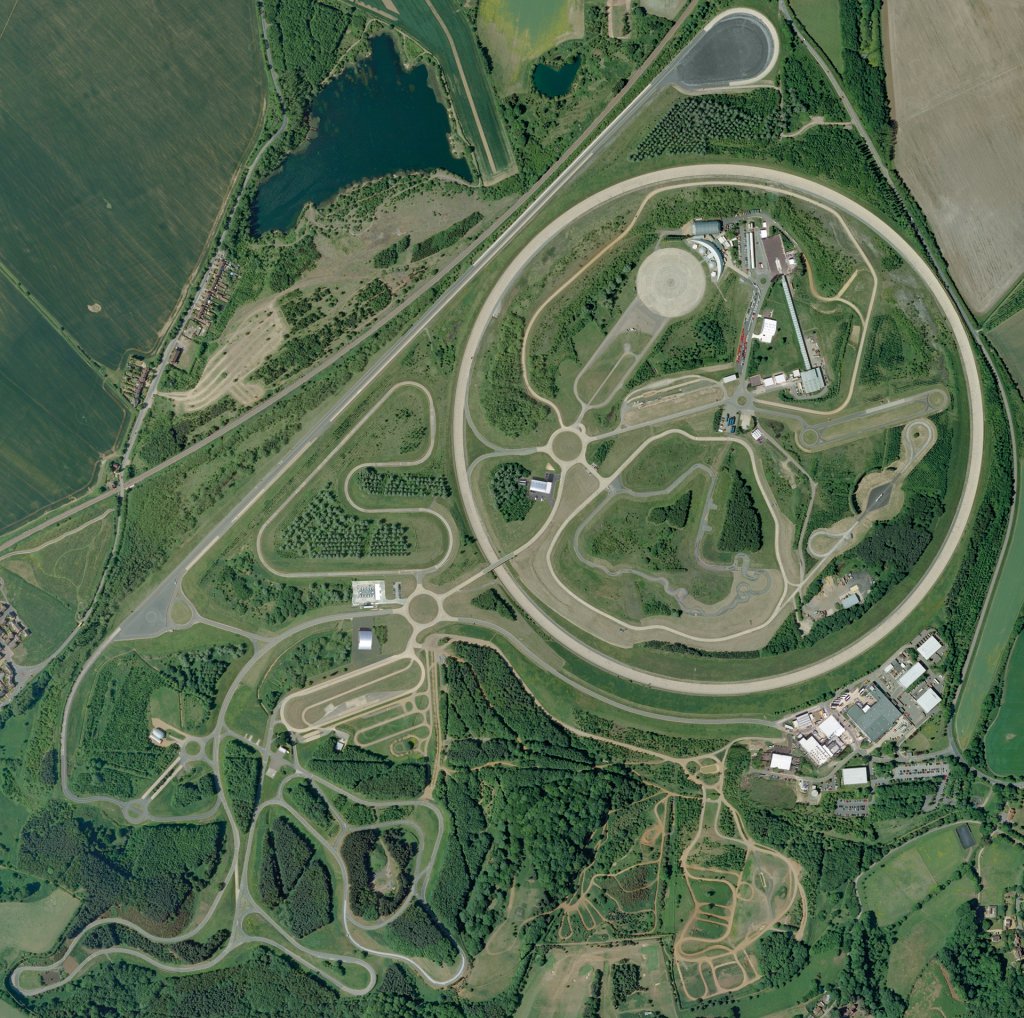
The UK’s Controlled Urban Testbed was the first in the CAM Testbed UK family to be completed and opened for business in September 2019. Millbrook’s Autonomous Village is our bespoke garage and office complex, which is home to the simulation suite. This enables the real and virtual worlds to mix, correlate and experiment in close proximity to extensive track and laboratory facilities. Partnered with the UK Atomic Energy’s Culham Science Centre, our testbed offers customers those first steps on the journey between concept and the public roads.
Backed by comprehensive test assets, including the very latest ADAS assessment tools and equipment, precise location services and open source reference vehicles, our testbed helps customers develop at pace in a repeatable, safe, private environment. Progressing along the customer journey to RACE at Culham enables our customers to prepare for public road deployment.
With access to the extensive virtual facilities at our testbed, developers can create virtual events using augmented and virtual reality for vehicles on track. The Millbrook virtual environment closely models the real world tracks and users can work on the complete virtual spectrum from software in the loop, through hardware, sensors, driver and full vehicle in the loop in full control.
Our testbed was recently the location for a project to demonstrate how future connected solutions could revolutionise patient diagnostics and treatment in the field, as well as reduce hospital numbers. This involved us equipping a standard ambulance with state-of-the-art devices and connectivity to create a “Smart Ambulance” that simulated 5G connectivity, transforming the vehicle into a unique remote consultation room. We provided access to the secure, private network, tracks and facilities to safely test the connectivity. This is just one of our many use cases that demonstrate the utility of our network and the Smart Ambulance project is one that could make a real difference to society.
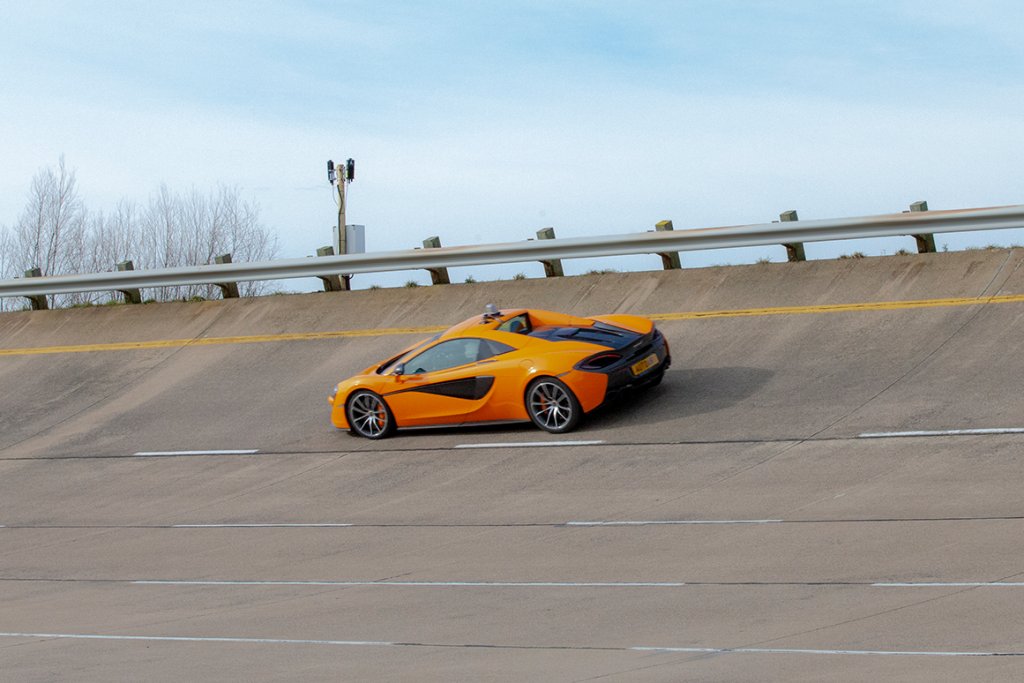
We are a founding member of the Zenzic cluster and part of the steering group, but the key partner in the CAM Testbed UK environment is the UK Atomic Energy’s RACE division who deal with remote applications in challenging environments in the nuclear industry. They see autonomous vehicles as remote applications within the road space as the challenging environment.
We are partnered with RACE to provide one testbed across two locations and form one part of the connected customer journey across the UK ecosystem. Developers can test and practice in an environment “close to public roads” across our 200 acre site. Customers then progress onwards to CAM Testbed UK public environments, or more extreme dynamic testing as their development plan sees fit.
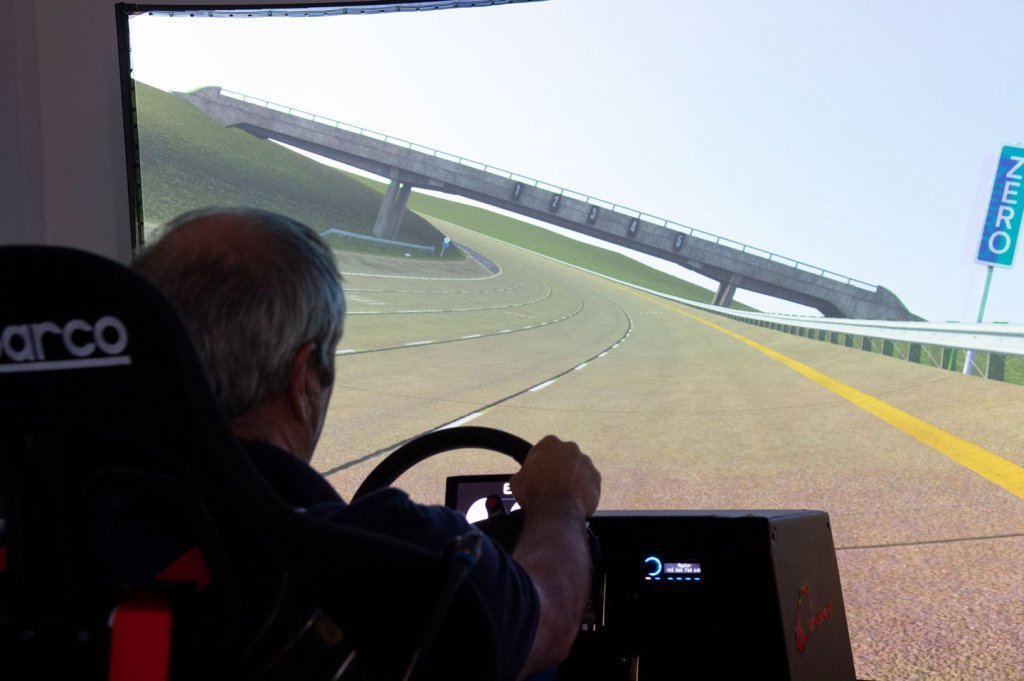
Our tracks. Our UK Proving Ground includes a High Speed Circuit, Hill Route, Mile Straight and City Circuit, as well as off-road courses and special surfaces. High fidelity communications are fully implemented across the site, so customers have continuous access to our private network whilst testing at high speed and on the Hill Route.
We have also developed a unique simulation environment that helps drivers to become accustomed to our tracks and specific vehicles before driving on our physical proving ground. Our tracks have been digitally modelled with 1mm surface accuracy and we can simulate a variety of weather conditions, including rain, snow, sleet, changing light, clouds and sun angles. Applications for our simulator suite include CAV development and driver training. Our comprehensive, diverse and unique facilities enable companies to test and develop their connected and self-driving vehicle capabilities.
Find out more about Millbrook via the website or contact info@millbrook.co.uk for specific queries.
TaaS Magazine and website offers advertisers fantastic opportunities to reach those involved in the Connected & Autonomous Vehicles and Future Mobility Industry. With packages to suit every budget, take a look at our media kit and get in touch to get involved with the TaaS portfolio of products.
Contact us on the details below to talk about your editorial, advertorial or advertising needs.
T: +44 24 7671 8970
Published by: Angel Business Communications Ltd, 6 Bow Court, Fletchworth Gate, Burnsall Rd, Coventry CV5 6SP. T: +44(0)2476 718970. ISSN 2516-5895
All information herein is believed to be correct at time of going to press. The publisher does not accept responsibility for any errors and omissions. The views expressed in TaaS magazine are not necessarily those of the publisher. Every effort has been made to obtain copyright permission for the material contained in this publication. Angel Business Communications Ltd will be happy to acknowledge any copyright oversights in a subsequent issue of the publication. Angel Business Communications Ltd © Copyright 2018. All rights reserved. Contents may not be reproduced in whole or part without the written consent of the publishers.
The automotive industry has been one of the most impacted industries in the world following the economic downturn of the recent global crisis. According to Frost and Sullivan, COVID-19 triggered an 80%-100% drop in physical visits to automotive showrooms. As a result, digitalization in the automotive industry has become an extremely meaningful tool for growth.
Up until recently, not all OEMs and dealerships viewed digitalization as a required asset to remain relevant and competitive. However, with the dramatic drop in visits to vehicle showrooms worldwide, along with the rising expectations for contactless buying experiences - digital showrooms are becoming the empowering platform for automotive retail and aftersales, and are allowing new, and safe ways to engage with customers and create new revenue streams through sales and subscription models. In their latest press release, Frost & Sullivan reported that online retail models are now projected to account for 1 million vehicles sold in 2020, and are expected to increase to over 6 million by 2025 - accounting for over 50% of global online revenues.
“The fear of getting infected by COVID-19 is turning people’s preference back to personal mobility. So, the recent decline in car sales is likely to be reversed very soon in places where automakers and automotive retailers move fast, redefine the customer journey, meet customer demands and provide a seamless digital experience” Said Fleetonomy’s CEO & Co-Founder Israel Duanis.
Can Digital Showrooms Replace Physical Showrooms in Times of Social Distancing?
Despite the recent rise in the need for a digital experience, it seems that the role of physical dealerships will not be lost entirely, as most customers still might want to visit them for final test drives or for different purchases.
As the global financial crisis following the COVID-19 pandemic might make it harder for people to commit to long term deals, flexible vehicle subscription models may become the answer and are already expected to grow rapidly. Vehicle subscription models are allowing customers who aren’t ready to purchase a vehicle of their own, to still enjoy one, while automakers and dealerships get to serve their clients in a way that best fits their needs.
Contactless car sales involve connecting online with customers and introducing them to a new way of shopping for a car or subscription deal without having to physically visit a showroom or dealership. In a digital showroom, customers can review products, packages, and receive all the information they need on their journey to buy or subscribe to the car that fits them best, with the help and guidance of certified dealers. Furthermore, businesses that will be able to offer both subscription and sales models within their digital experience will be able to offer more to their clients and create a competitive edge in these crucial times.
Digital showroom platforms allow buyers to personalize and offer a wide range of products according to their customer’s needs. Product information, as well as customized service packages or financial options, can be easily reviewed independently by the buyer, while questions and thoughts can be addressed in real-time by a dealer online.
The digital approach is being adopted widely and a large number of carmakers worldwide are already available online with their own OEM-powered digital showrooms and dedicated sales websites. The implementation of the right cloud-based software can provide dealers with the opportunity to monitor and optimize the entire customer journey and drive vehicle sales up.
In this context, Frost & Sullivan recently stated that alongside sales, online retailing will emerge as a critical channel in terms of providing vehicle services as well. Revenues generated by online vehicle retail, online services, and digital aftersales are predicted to grow almost five times from $120B to $605B by 2025. This means that by 2025, almost 6 million new vehicles are expected to be sold online.
The Online Showroom - From Software to Sales
Along with analytics and traceability, a full software solution should provide a real-time flow of information between the customer and dealership. In the digital journey, a buyer would initially express interest in a brand’s vehicle through its app or website, where a lead can now be nurtured. With an integrated digital showroom in place, a buyer could access different products and financial information via mobile app or website. He or she can then receive access to the contact details of a representative and schedule a personal virtual demo. Finally, the buyer can then be directed to the closest dealership in proximity with the customer for a scheduled test-drive, or even book the demo to arrive right at the customer's doorstep.
To learn more about Fleetonomy’s digital showroom platform, trusted by global top-tier OEMs worldwide - contact our team at info@fleetonomy.io

